17. THE POST-WAR WORLD

ASIAN INDEPENDENCE
CONTENTS
 American "Anti-Imperialism ... and the American "Anti-Imperialism ... and the
Philippines
 Gandhi and Indian independence Gandhi and Indian independence
 The collapse of the Dutch East Indies The collapse of the Dutch East Indies
Empire
 The French stumble in Indochina The French stumble in Indochina
 Mao takes control in China Mao takes control in China
 The Israeli-Palestinian Question The Israeli-Palestinian Question
The textual material on page below is drawn directly from my work
A Moral History of Western Society © 2024, Volume Two, pages 224-236.
AMERICAN "ANTI-IMPERIALISM" ... AND THE PHILIPPINES |
|
America’s "anti-imperialism"
America could be irritating to its allies at times. Something of
the old Wilsonian Idealism lingered on in America when it came to the
idea of "making the world safe for democracy." America had always
been uneasy about its European allies' empires in Asia and
Africa. Yet at the same time, America never admitted that it had
a "sphere of influence" in Latin America (and elsewhere) that often did
not operate much differently than did the European Afro-Asian empires!
The Philippines
The classic example of this is the Philippines … taken from Spain by
the Americans in the Spanish-American War (1898) and then placed under
American "protection" … to the astonishment and anger of the Filipinos
who had believed that American involvement in that war was designed
solely to bring about Philippine independence … not dependence.
Thus a new and quite ugly war broke out, Filipinos now against their
American "liberators."
This finally embarrassed America enough that it made some promises to bring the Philippines – in stages – to full independence.
The outbreak of World War Two interrupted the final move of America to
bring the Philippines to full independence. But with the end of
the war – and with great fanfare – the Americans finally took down the
American flag in Manila (July 4, 1946) and raised in its place the
Philippine national flag … formally ending the status of the
Philippines as some kind of American dependency.
And the Americans were loud in announcing how this move to national
independence (and supposedly thus – automatically – also to full
"democracy") of the Philippines was to be a model to all … friend and
former foe alike. A new era was upon the world. President
Wilson's earlier "universal right of self-determination" was now the
new norm that would prevail everywhere … as the sure and certain
guarantee that this time around, a true and lasting (eternal even?)
peace and brotherhood for all peoples of the world was about to finally
take place. Thus the world needed to get on board with the
American train heading to such global glory.
The political Idealism of the new American superpower
Most sadly, as a new global superpower that the Western world would
look to for its protection from rising aggressions coming from the
Stalinist East, the ability of Americans to disregard the hard
political lessons of their nation's own rise to power was (and still
is) truly alarming. Idealistic Americans conveniently forgot
about their own spread across the North American continent – brutally
driving Indians tribes from their lands in order to make room for
incoming European settlers (also forgetting the brutality of the
"gentle" Indians themselves in their own fight to hang onto those same
lands). These Americans conveniently forgot the cost in human
lives of the war in their own country over the matter of ending slavery
in America once and for all. And somehow they once again believed
that the recent horrific spilling of blood in Europe and Asia was some
kind of final price to be paid – for a peace that would never again
require such a cost to maintain.
At the same time, they chose to see themselves and their country in its
rise to prominence simply as a result of the wonderful "democratic"
character of the American people … a proper moral – and certainly
political – example for the other peoples and nations of the world to
follow.
In short, to the thinking of the Americans – with a whole new postwar
world unfolding before them – the world had, once again, the
opportunity (which it had squandered at the end of World War One) to
set a course that would finally bring truly-lasting global peace.
But that would require their European friends, the British, French,
Dutch, Portuguese, Belgians, etc., to close down their empires in order
to give the remaining oppressed people of the world the right to come
to their own self-determination (self-government) as independent – and
thus naturally also a democratic and peace-loving – people. There
was no other path to world peace. |
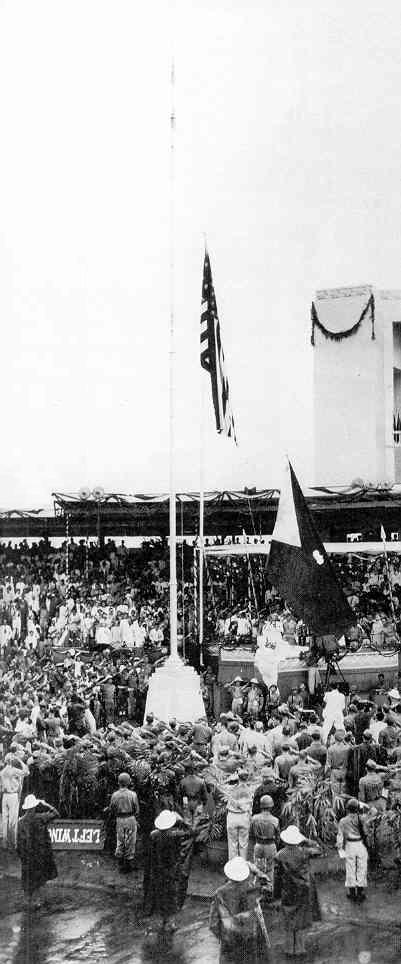
The US flag comes down in
the Philippines - July 4, 1946
GANDHI AND INDIAN INDEPENDENCE |
|
Atlee
as Gandhi's most important ally
Actually, Gandhi had an ally in
the British government itself, one that took control in London in the
days immediately after the Nazi political collapse in Europe … namely
the new Labour government led by Clement Atlee. Atlee understood
himself to be in power solely to represent the working classes of Great
Britain … and little beyond that. He had no interest in
supporting the larger world of the British Empire. In fact, as
already noted, he held the firm belief that it was the Empire itself
that had served to keep the British worker in poverty … as Indian labor
could always be counted on as being much cheaper for capitalism to find
its profits. Thus to Atlee's thinking, the best thing Britain
could do was to send India on its way … as soon as possible. Thus
Gandhi's "Quit India" program had an invaluable ally at the very heart
of Britain itself.
Major difficulties with Gandhi's Indian nationalist dream
A
major problem, as also already noted, existed in the fact that India
was not actually a nation at all, but a European-sized subcontinent
made up of hundreds of long-standing states, large and small, ones that
Britain had managed to bring together as a single political unit.
In eliminating that British-enforced unity, a huge problem of different
languages, different religions, and long-standing local rivalries would
be brought forward … violently.
Certainly Gandhi was aware of this potential for trouble ... horrible
trouble. But, like all such political "saviors," he somehow
believed that he had the charismatic power to keep his India unified
and moving forward once the British were out of the picture.
In any case, the problems hit just as soon as there was some indication
that the British were indeed going to Quit India. Most
importantly, there were numerous Muslim communities located here and
there around the Indian subcontinent … Muslim communities that were
concerned about what would happen to them in coming under the mastery
of the very symbol of traditional Hinduism, Gandhi.
The British had been rather willing to let the various religious
traditions of the Indians continue as before … not something that the
Muslims expected to continue once the British departed. Thus they
immediately pressed the British for guarantees that they could go their
own Muslim way with the British departure. In short, they wanted
separate Muslim states (or state) of their own to be set up – quite
apart from Gandhi's India.
But how that was to happen was not exactly clear. Not only were
there distinct Muslim states located here and there in both the East
and the West of India, but Hindus and Muslims were to be found in some
kind of combination mostly across all of India. Thus to set up a
separate Muslim State – which the Muslim were calling "Pakistan"1 – was
not going to be an easy matter … especially with Gandhi deeply opposed
to the idea.
And what about the large community of Sikhs … found mostly in the also
highly Muslim world of the Indian northwest … Sikhs who once had a huge
empire reaching across northern India and southern Afghanistan?
Where did they belong in the midst of any Hindu-Muslim division of
British India?
But the British were quickly losing interest in resolving these
difficult questions … being simply in a hurry to get out of the matter
as soon as possible. Thus British Lord Mountbatten (a member of
the British royal family and Viceroy of India) was given instructions
by Atlee's government to prepare India for independence by at least
1948 … but preferably sooner if possible. Thus in June of 1947,
Mountbatten pushed representatives of the various Indian communities
(Gandhi did not participate – being adamantly opposed to any division
of his India) to agree to accept various state boundaries … for the
British would be soon departing (August 15 of that same year).
Seeing this division headed their way, very quickly India became the
scene of millions2 of Indians scurrying to relocate themselves to one or
another community, according to their religious identities … with the
Sikhs having no place in particular designated for them.
Tragically, hundreds of thousands3 would die in the chaos that
accompanied this mass movement.
Gandhi, not understanding the forces he had unleashed, tried to bring
down the level of hatred involved in this new dynamic by going into
another one of his fasts (merely five days, however) – which had been
able previously to redirect British policies … but which had absolutely
no impact whatsoever on the present chaos.
Gandhi is assassinated
Then in early 1948, with popular passions
still running hot, Gandhi himself was gunned down by a Hindu fanatic,
Nathuram Godse, a Brahmin who was embittered by Gandhi's toleration of
Muslims ... plus his own social slippage due to personal business
failures and the general loss of Brahmin caste privilege under the
impact of the modern world.
Actually, it was merciful that it was a Hindu who gunned Gandhi down,
for had it been a Muslim, the violence would have been explosive in the
extreme.
But actually Gandhi's removal from the scene did India something of a
favor … for not only did it sober up the extremists a bit, it brought
Jawaharlal Nehru forward as India's new leader … someone ultimately
dedicated to the idea of moving India forward into the rising
industrial age – and not forcing it back into Gandhi's highly
romanticized agrarian past – an issue that would soon have divided
India into two strongly opposing pro-Gandhi and pro-Nehru
parties. And it certainly spared India from the economic
catastrophe (mass starvation) that would have occurred if Gandhi had
succeeded in moving India in his direction.
In any case, as it turned out, India would continue under the guidance
of Nehru until his death in 1964 … and then under members of his family
after that date.
But as it also turned out, it would create a vicious rivalry between
Hindu India and the two Muslim Pakistans (East and West) existing on
both sides of India … a rivalry that produced numerous wars – and the
decision of both India and Pakistan to go nuclear in their military
programming … a program prompted by this same Indian-Pakistani rivalry.
1Part
of the name came from istan meaning place or land; Pak has a dual
source as both the Urdu word for pure (thus Land of the Pure) or simply
the acronym for the northeast region of Punjab, Afghanistan and Kashmir
... or cleverly, both.
2The United Nations estimated that 14 million people were displaced during this migration.
3The exact death count is hard to calculate. The numbers vary from a low of 200,000 to a high of 2 million.
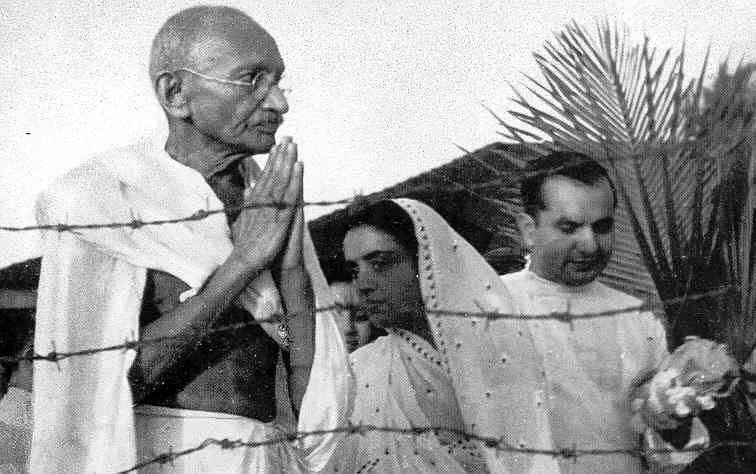 Gandhi after release from
prison in May 1944
Gandhi after release from
prison in May 1944
| In early 1942, at a time
when the
Japanese were threatening to overrun the British Empire everywhere, Gandhi
decided to resume his civil disobedience campaign to topple British authority
in India. He refused to cooperate with the British in fending off
the Japanese - and was arrested and detained for the next 21 months. |
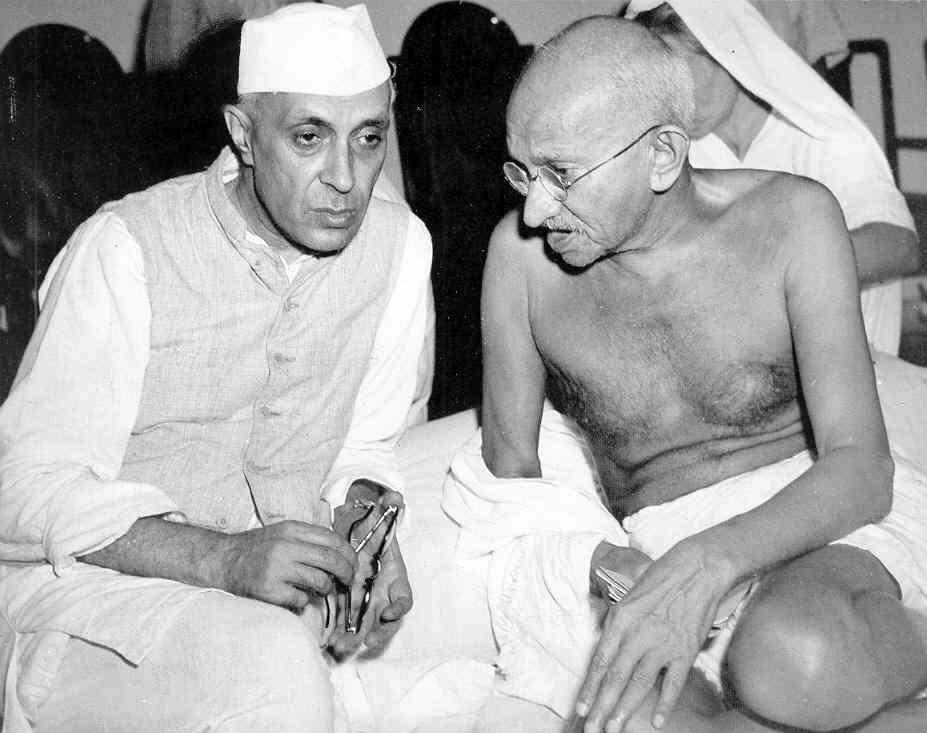
Gandhi and Jawaharlal Nehru
confer at a meeting of the Congress Party - 1946
Muslim leader Muhammad Ali
Jinnah meets with British officials to plead the cause of
an independent
Pakistan, a separate Muslim state
carved out of British India –
something which Gandhi hotly opposed

Vultures and dead victims
of religious rioting - August 1946. The rioting occurred
when Ali Jinnah of
the Muslim League called on his people to demonstrate against Hindu-dominated
Indian Congress Party of Gandhi and Nehru
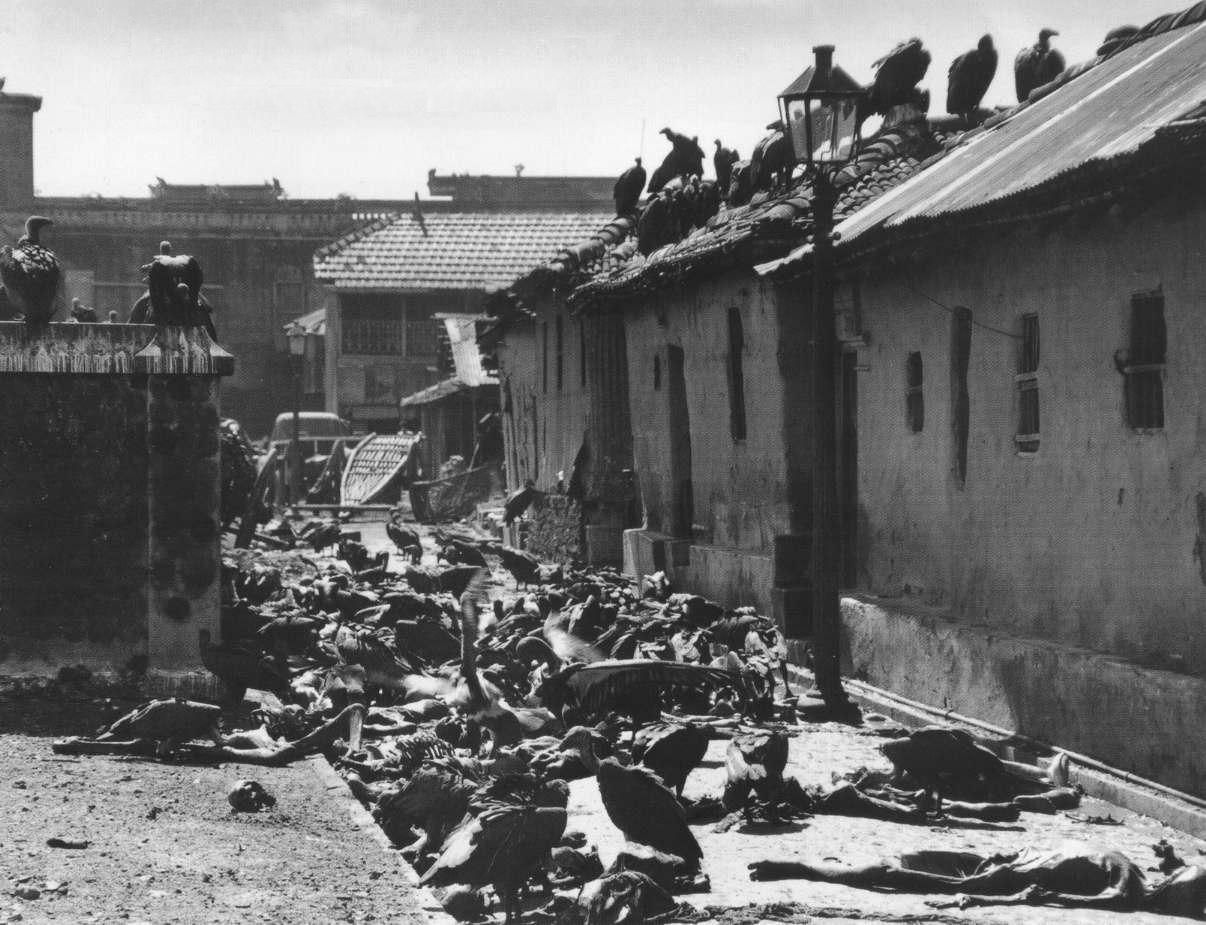
Vultures preside over those
killed in Muslim-Hindu violence in the approach to Indian independence
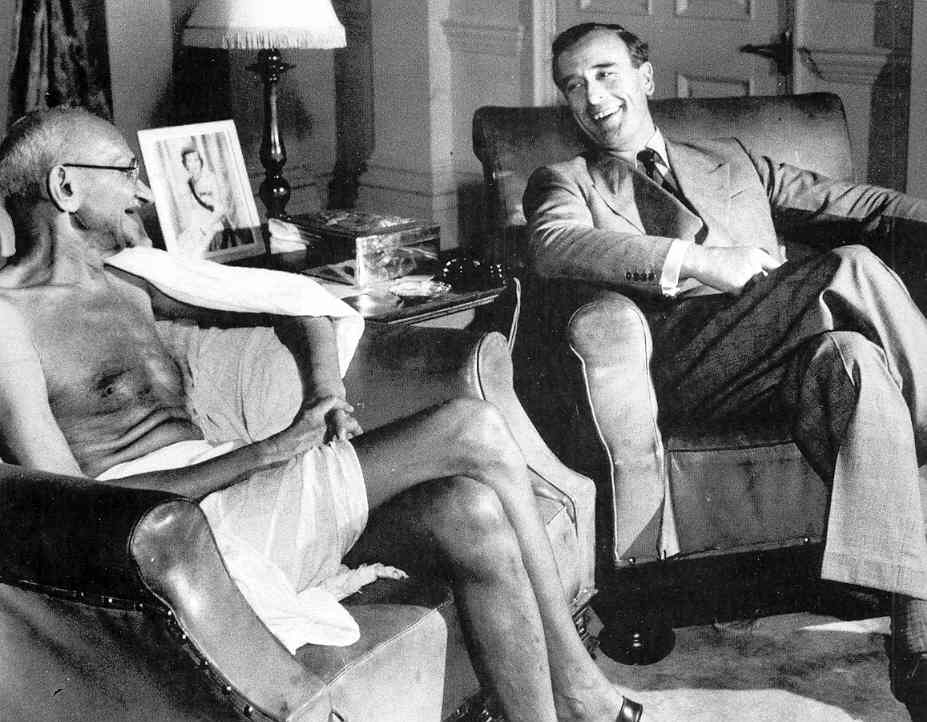
Gandhi confers with Lord
Louis Mountbatten in the days before Indian independence - 1947 
Muslim refugees passing a
shallow grave of victims of an attack by Sikhs
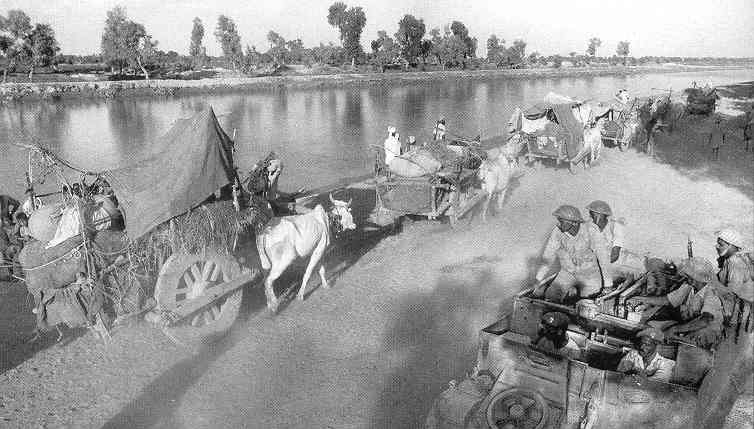
Refugees making their way
from Pakistan to India under military protection - 1947 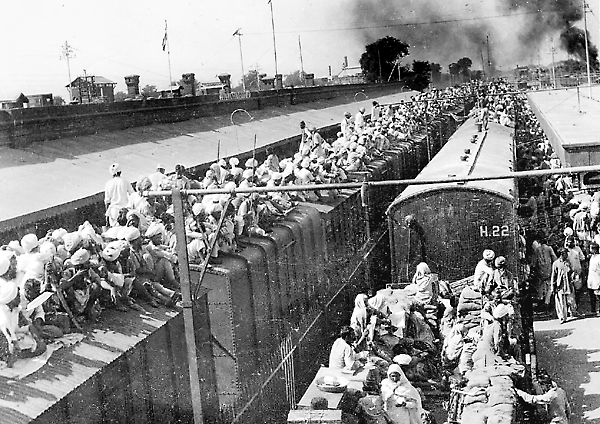
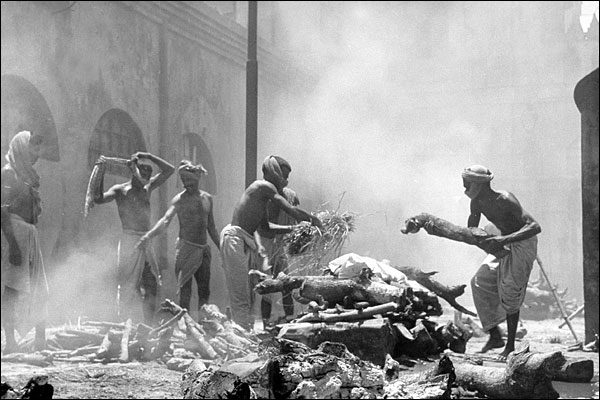
Indian partition ... killing and cremation

Refugee trains taking Indian Sikhs and Moslems in opposite directions
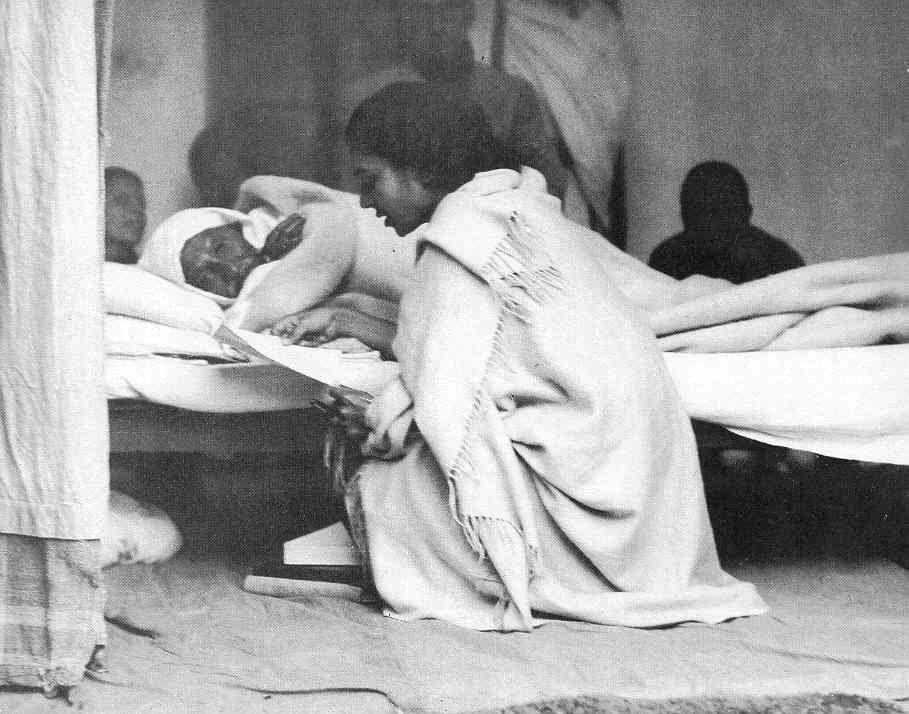
Gandhi on the 5th day of
his fast to compel the Indians to cease the Hindu-Muslim
violence against each other - January 17, 1948
After
only five days, he presents himself as if he were at the edge of death
... hardly the case, but very dramatic ... and supposedly politically
very effective. Great political drama, Gandhi!
He ended the fast the following day when leaders of both communities met to sign a peace agreement.
12 days later (January 30th) he was assassinated by a Hindu fanatic who was embittered
by Gandhi's toleration of Muslims. Ironic
justice for the London-trained lawyer Gandhi ... in his highly
Romanticized effort to bring down India's well-developed social system
(which was too "English" for him personally). |
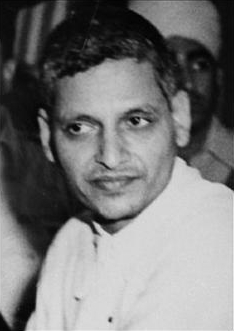
Hindi fanatic Nathuram Godse ... who assasinated Gandhi because of his call for religious tolerance
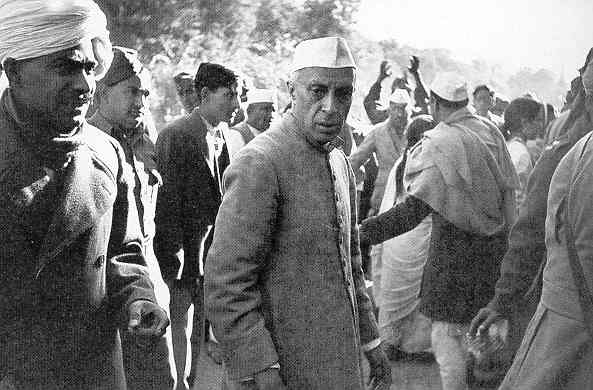
Nehru and others in grief
over the news of Gandhi's assassination
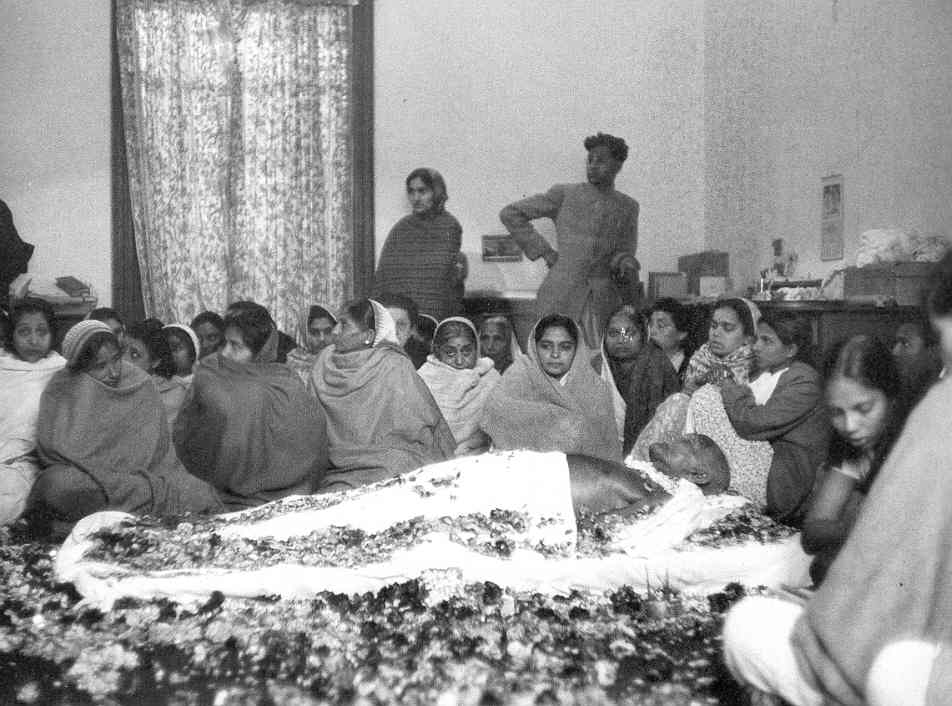
Hindu women keeping vigil
beside the body of Gandhi
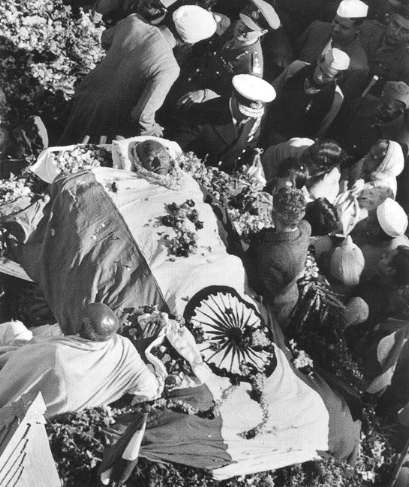
Mahandas "Mahatma" Gandhi
lies in state - 1948
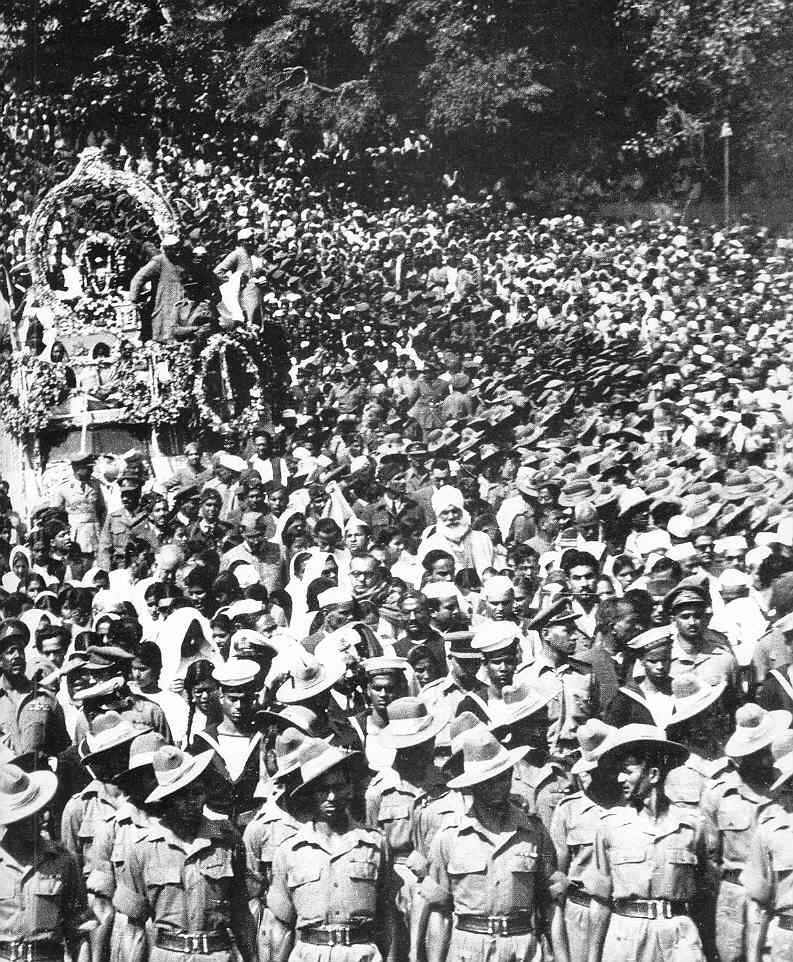
The funeral procession carrying
Gandhi's body to the Jumna river where it is to be cremated
By the spring of 1948
when the worst
of the cross migration of Muslims into Pakistan and Hindus into India had
finally slowed down (the Sikhs had no land of their own to migrate to)
as many as 15 million people had been transplanted in the two new countries.
The figures of those who died in this massive upheaval are unknown:
estimates run from several hundred thousand to as many as a million.
And it left, deeply embittered, even millions more ... Muslims versus Hindus. |
THE COLLAPSE OF THE DUTCH EAST INDIES EMPIRE |
On
the other hand, the Dutch were not as ready to give up their overseas
holdings in Asia as had been the British. For the Dutch, their
investment in their extensive holdings in Southeast Asia had been built
up over a period of three centuries … much longer than even the British
involvement in India. And over that long period a very deep
cultural, economic, and political link between the Netherlands and the
Dutch East Indies had served both societies quite well … because the
Dutch had proven very effective in keeping a quite tight control over
the entire region.
And the Dutch quite naturally felt that, with the war over, they would simply put that same relationship back in place.
Of course the three-and-a-half-year period of Japanese occupation of
that same region had done much (quite purposely on the part of the
Japanese) to undermine that linkage between the Netherlands and its
Asian colony. And the Japanese, even in defeat, worked very hard
in their last days of occupation of the region to leave behind as much
of an anti-Western social legacy there as possible. Indeed, still
in occupation of the region after the formal surrender of Japan to the
Allies, the Japanese supported strongly the efforts of a local
nationalist leader, Sukarno (active even before the start of the war in
an anti-Dutch independence movement) and his close associate Mohammad
Hatta, to establish an independent "Indonesia" … Sukarno declaring
himself president of the new republic and Hatta vice president.
Furthermore, the weapons that the Japanese had to turn over to their
victors went mostly to arm the Indonesian nationalists.
But the situation – for both Sukarno and the Dutch –
was a very complicated matter ... because the region was hardly a
unified social entity. Languages across the region varied, as did
the religion … though mostly it was Muslim in character. But many
of the islands making up the region were Christian. And there was
a huge Chinese sector of the population. And of course there were
many European Dutch who had long made the area their home. Thus
the region quickly became the scene of frequent ethnic massacres.4
And the Dutch, whose homeland had been demolished by the Germans, found
themselves absorbed back in Europe with rebuilding their society.
Indeed, since the war's end, the Dutch had been forced to rely on the
rather limited support of British Indian and Commonwealth troops in
their East Indies colony … largely sent to the region just to oversee
the Japanese surrender. And thus it was not until early 1946 that the
Dutch were finally able to send their own troops to their colony in an
effort to bring things back under full Dutch control.
Actually, by 1947, the Dutch seemed to be largely succeeding in their
effort, having brought the major islands of Java and Sumatra back under
Dutch control. But they found that local resistance was now being
replaced by international resistance … in particular in the New United
Nations, where Sukarno and his Republicans seemed to be finding a lot
of support. Australia, newly independent India, the Soviet Union
– and even America – were tending to side with Sukarno and the
Republicans. Finally, the Dutch bent to U.N. efforts to secure a
cease-fire between the two parties, put in place largely along the
lines where one or the other party seemed to be in control.
But Sukarno, enjoying rather significant international support
(and growing support at home), was not really interested in respecting
the cease-fire … and continued to press forward his nationalist
movement.
The Dutch, seeing themselves facing an increasingly desperate
situation, thus decided in late 1948 to make a huge push to put
themselves back in command – regaining much of the urban regions in the
process, though finding themselves stalled in the countryside ... and
worse, coming under ever-stronger opposition in the UN. At this
point, America not only cut off all Marshall Plan aid designated for
the rebuilding of the Dutch colony, but threatened to do the same for
the rebuilding of the Netherlands itself. Americans were highly
incensed by the idea that probably half of the budget designated for
the rebuilding of Indonesia was going to support Dutch military efforts
in the region. That was imperialism … and there was no way that
America would ever support such a program.
By the summer of 1949, the Dutch were ready to quit. They
ultimately (November 1949) worked out an agreement recognizing an
independent Indonesia, under the presidency of Sukarno … the man who
would continue to rule the Republic of Indonesia as a dictator – all
the way up until 1967, when he was forced out of power by another
Indonesian strongman, Suharto – who would then rule Indonesia for the
next thirty-one years.
So maybe European imperialism got put aside in Indonesia through this
effort of America and others. But that move hardly led
automatically to the replacement of imperialism with national
democracy. But America largely ignored events in Indonesia in the
days and years that followed ... thus learning nothing from the
experience. And the Netherlands – no longer a global power – had
to decide how then to move into a deeply reshaped future.
4Tens
of thousands were reported killed or missing in the first year after
the war alone. Several thousand Europeans were known specifically
to have been tortured and executed and as many as 20,000 of mixed
European-Asian ancestry were killed or went missing (those missing
probably suffering a similar fate, though most likely their bodies were
thrown into the sea; some mass graves were later uncovered).
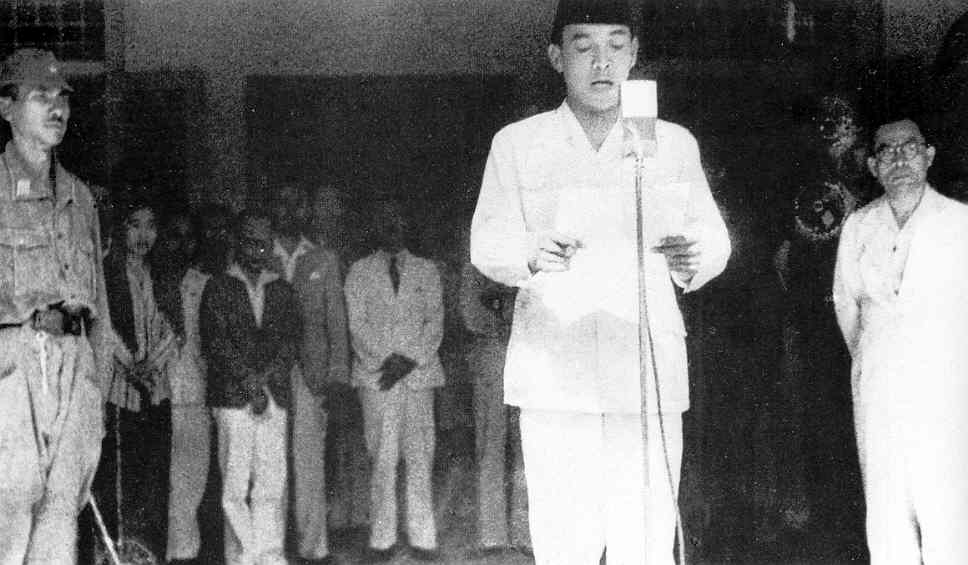
Sukarno (with Mohammed Hatta
on the right) announcing Indonesian independence - August 17, 1945 - two days after the Japanese
surrendered to the Allies
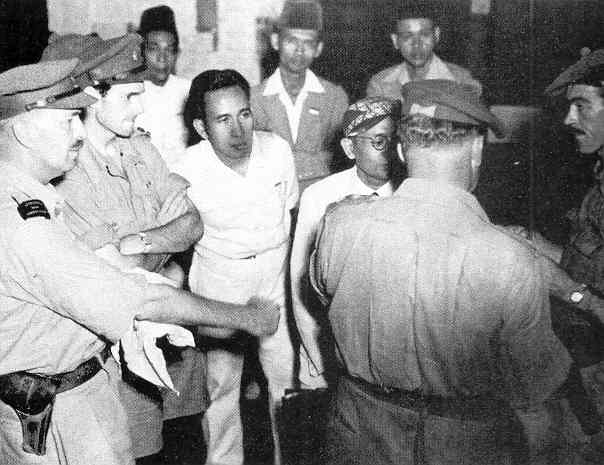
British soldiers, acting
on behalf of the Dutch,
questioning Indonesians about nationalist activities
- 1945
| Not until September did
the British
arrive in Indonesia, to take over from a greatly demoralized Japanese occupational
force – giving the Indonesian nationalists weeks of opportunity to establish
themselves. |
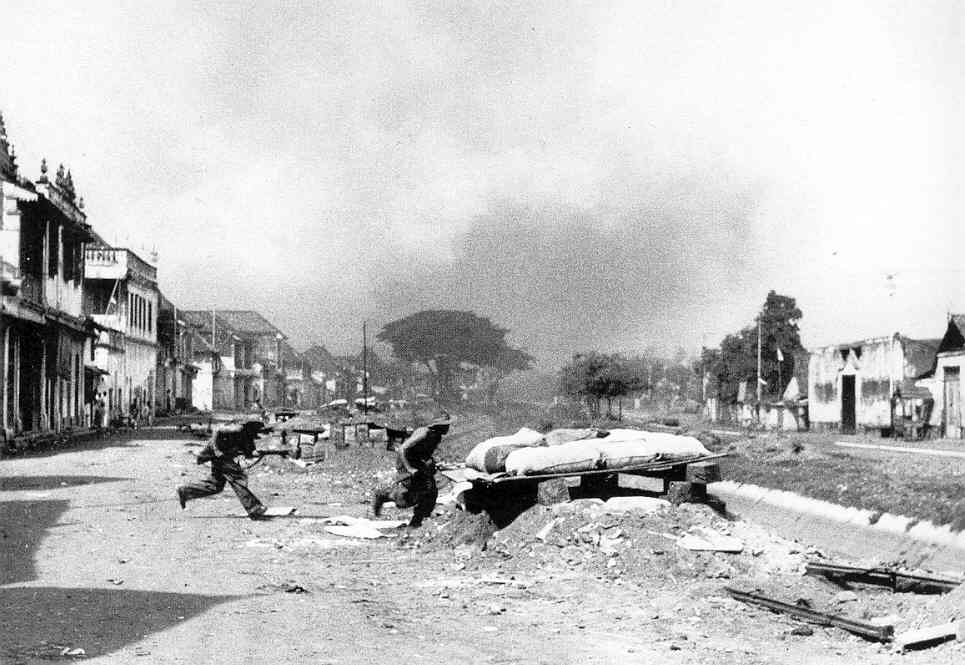
British Indian troops encountering
the first major uprising
of the Indonesian nationalists - November 1945
Imperial War Museum,
London
| When the Dutch finally
were able
to begin taking over from the British it was early 1946 -- and they found
themselves facing a well-developed nationalist movement among the
Indonesians |

Dutch soldiers and Indonesian
civilians at a checkpoint in Djakarta
Dutch Institute for Military
History

Skulls and bones of Dutch
civilians murdered during Indonesian Independence-Day celebrations at Balapoelang - August
17, 1946
Government Institute for
War Documentation, the Hague
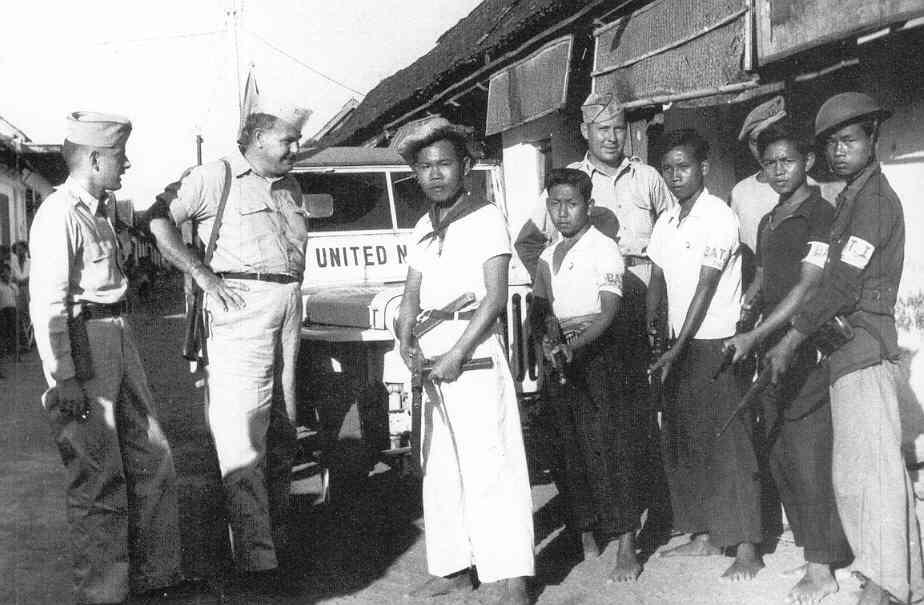
UN military observers checking
up on a UN-sponsored cease-fire - 1948
National Archives
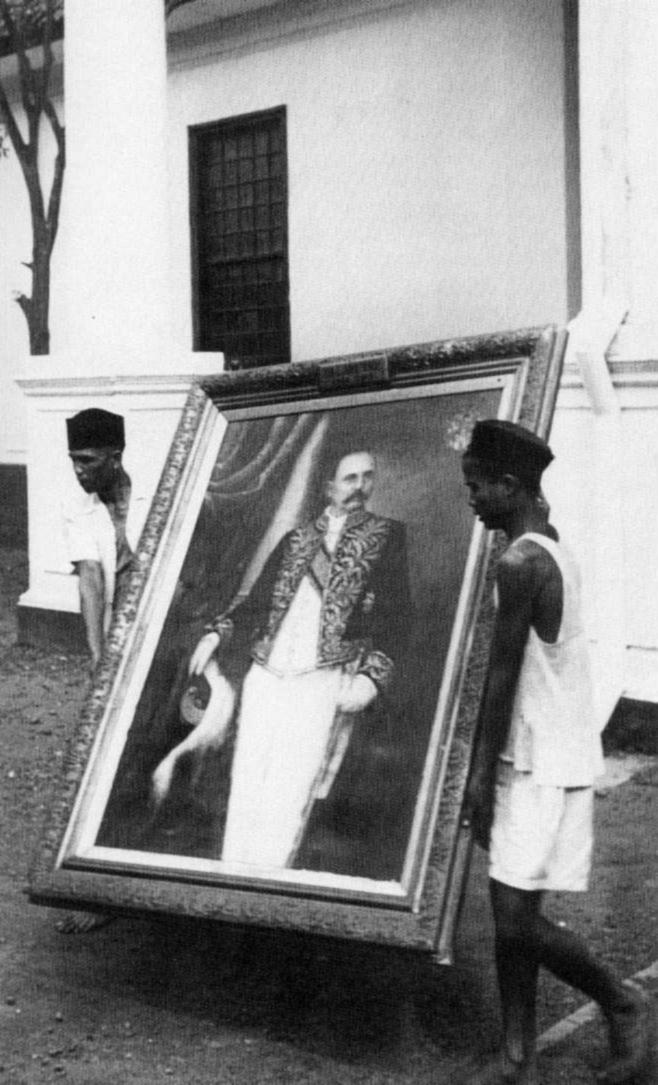
Indonesians remove from the
Djakarta palace portraits of their former Dutch governors - 1948

Aerial photo of Dutch parachutes
and cargo planes at Maguwo Airport near Jogjakarta
after Dutch paratroopers
and regular troops attacked the nationalist position there - December 19,
1948
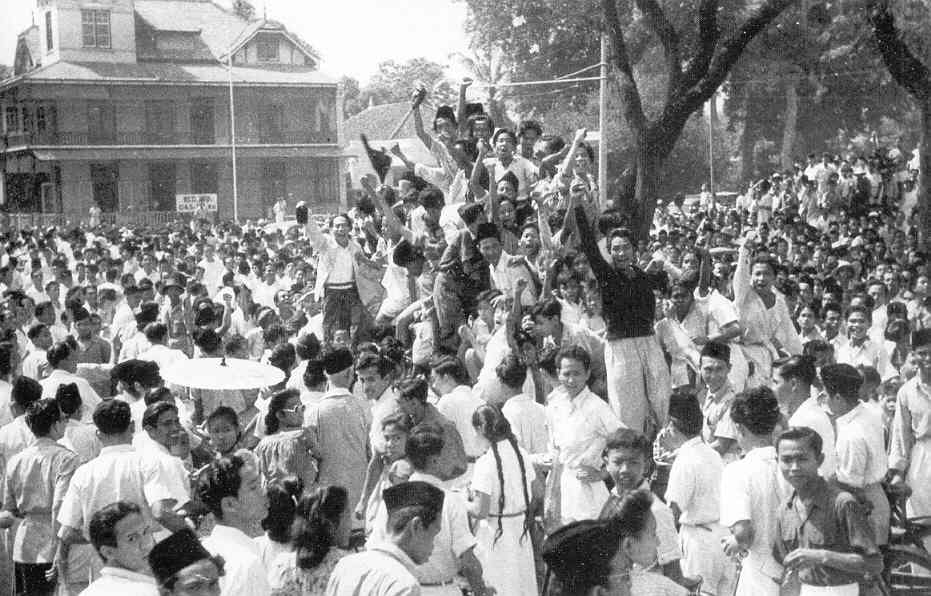
Crowds in Djakarta celebrating
the 4th anniversary of Indonesian independence - August 17, 1949
National Archives
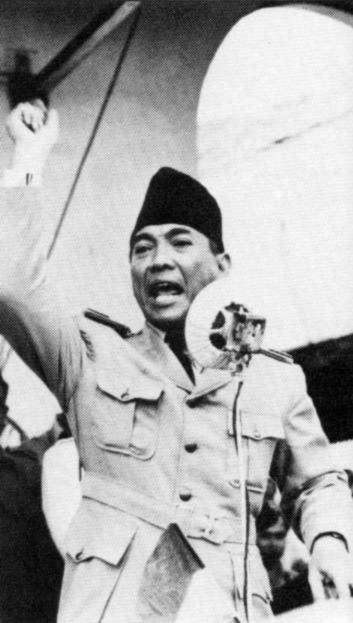
Achmed Sukarno challenging
his Indonesian countrymen to grand acts of patriotism
THE FRENCH STUMBLE IN INDOCHINA |
|
Troubles in French Indochina
Also naturally, the French had the full intention after the war, as had
the Dutch, to return to their holdings in Southeast Asia … to French
Indochina.5 But there too the European colonials found
independence movements well underway … helped greatly by Japan's
encouragement – but also by the weak hand there of the wartime French
Vichy government … which had simply let the Japanese take over their
colony during the war.
But even before the end of the war, Roosevelt had made it quite clear
to the French that America would oppose any effort of the French to
retake their colony in Indochina. In addition to the fact that
America was deeply opposed to such imperialism, the Roosevelt
government had been working closely with the anti-Japanese resistance –
the Viet Minh, made up of Vietnamese nationalists led by the Communist
Hồ Ch Minh. This group was expecting international recognition
of the region's independence from the French. And America was
willing to accord them just such recognition.
Thus just as the Japanese issued their formal surrender (September
1945) – and also turning their weapons over to the Viet Minh – Ho
declared the independence of a Vietnamese Republic. He quickly
took control of the city of Hanoi in the North … just as the French
(also assisted by British colonial troops) arrived on the scene to
receive the Japanese surrender.
At first Hồ hoped that the mutual sufferings of the French and the
Vietnamese would incline the French to be sympathetic toward his
efforts on behalf of Vietnamese independence. He also placed high
hopes in the French Communist Party and their electoral victory back in
France as insurance against a resurgent French colonialist impulse.
But negotiations over the summer of 1946 began to reveal to him that
the French had no intentions of granting the Vietnamese their
independence.
Fighting thus broke out (mostly in Tonkin in the North) not only
between the Viet Minh and the French but also between the Viet Minh and
the supporters of the young Vietnamese Emperor Bảo Đại – a curious
political figure who had served as a Japanese puppet during the war but
who now found himself in alliance with the French after the war
(willing to serve again as a puppet?).
The fighting was mostly sporadic …except for the one incident in 1946
in which the French bombed the port city of Haiphong, killing 6,000
citizens and scattering the Viet Minh into the countryside ...
making the ability of the French to run down their enemy even more
complicated.
In 1949, the French attempted to counter Hồ's nationalist appeal by
establishing the Republic of Vietnam – under the Emperor Bảo Đại – as
an Associated State within the French Union. They also set up a
Vietnamese National Army to support the new regime. Likewise,
Laos and Cambodia were also set up separately as Associated States
within the French Union.
But the victory in China of Mao's Communists that same year (1949)
encouraged the Viet Minh enormously. Meanwhile, Truman had
been approached for support of the Vietnamese independence
movement. But by the late 1940s the idea of supporting any
independence movement that might benefit the Communists was now
politically taboo in America. Indeed, by the early 1950s, America
was now also supporting the other side – that of the French ... as
clearly a "Cold War" had set in dividing the world into the "Free" and
their opponents, the "Communists." Things now turned very messy
in the region.
5Laos
and Cambodia, plus the three Vietnamese coastal regions of Tonkin in
the north, Annam in the center, and Cochinchina in the south./font>
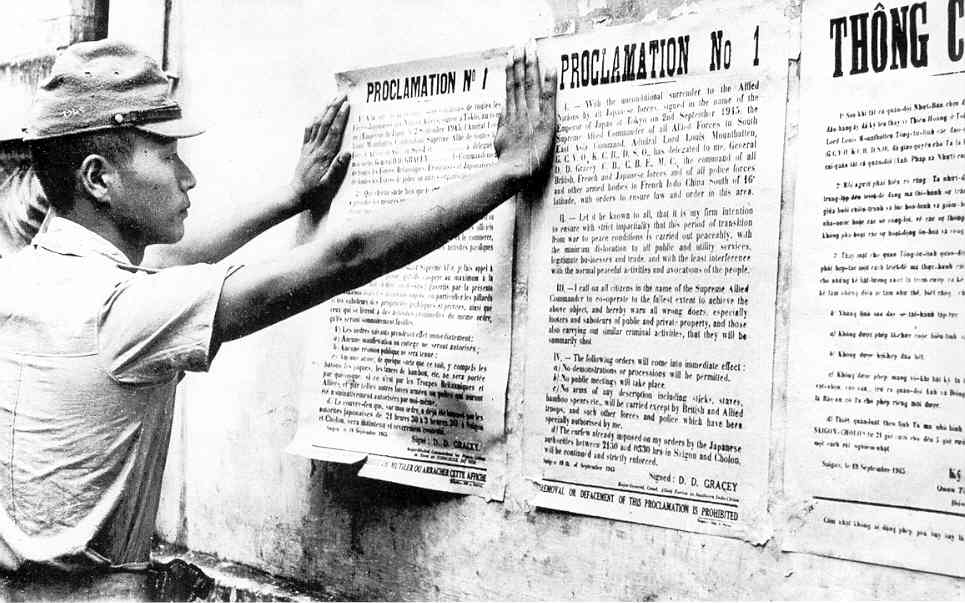
A Japanese soldier posts
Proclamation No. 1 declaring martial law – in English, French and Vietnamese – September 1945
Imperial War Museum,
London
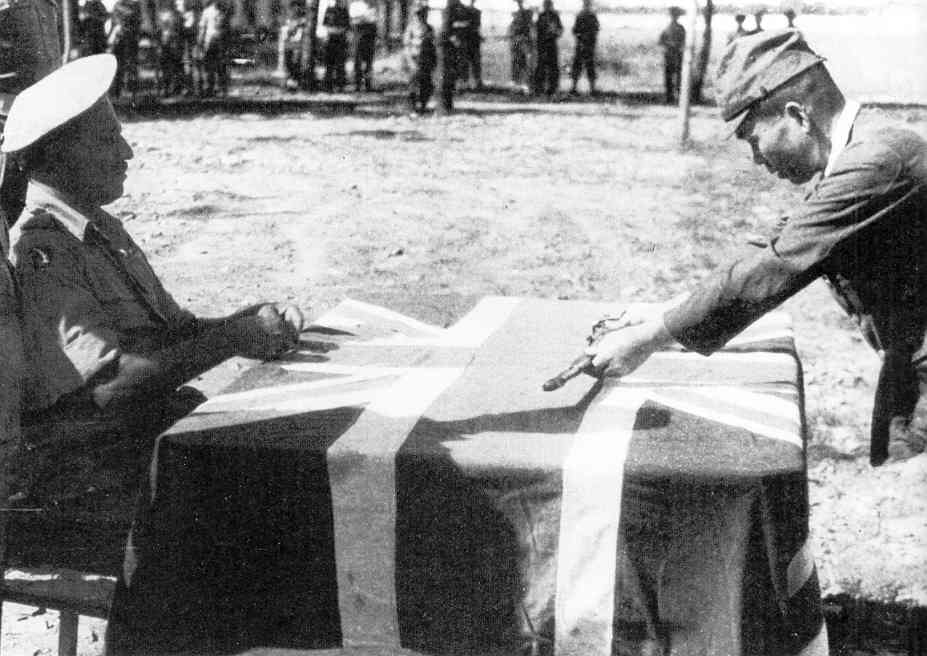
Japanese commander of a military
police unit in Saigon submitting his sword to a Indian officer in the
British army - November 1945
U.S. Army
| The British were the first
to enter
the Japanese-held former French and Dutch colonies. The British kept the
Japanese military in place for several months to help keep order
until their European allies could retake their former colonies. |
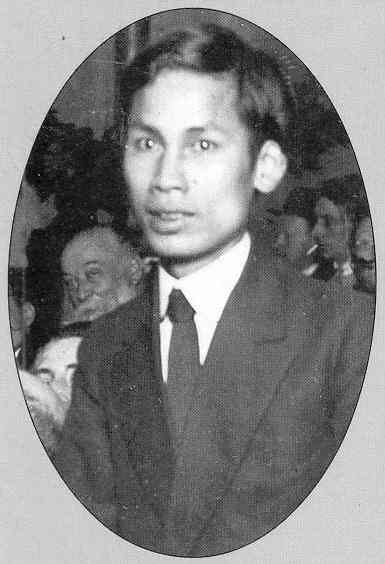
Nguyen That Thanh or "Ho
Chi Minh" ("He who enlightens") addressing the 1920 meeting which gave rise to the French
Communist Party, of which he was a founding member

Ho Chi Minh (center) and
Vo Nguyen Giap (far left) with American OSS agents planning coordinated action
against the Japanese - 1945
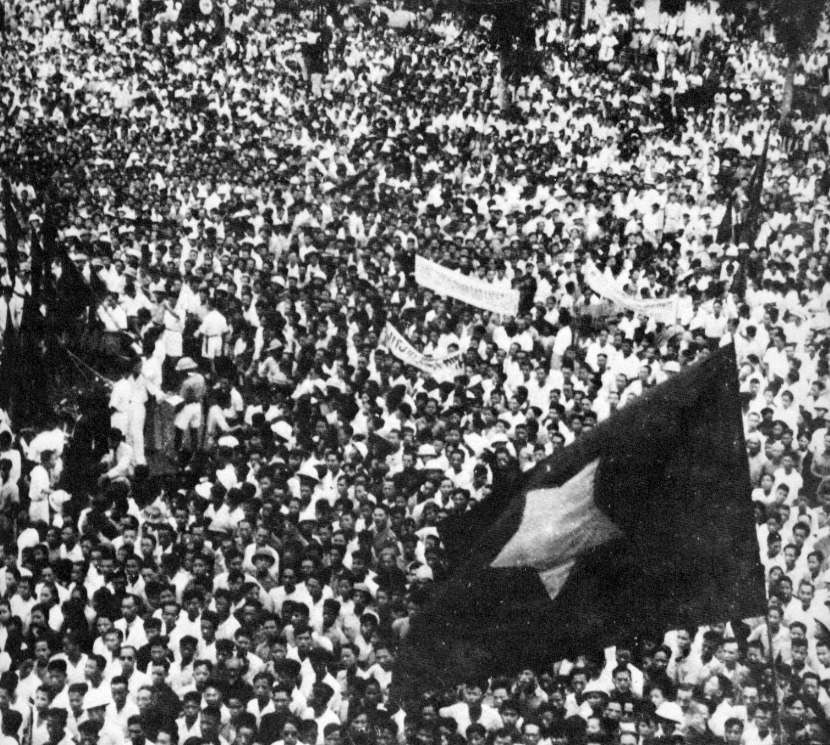
Ho Chi Minh proclaiming Vietnamese
independence - 1945
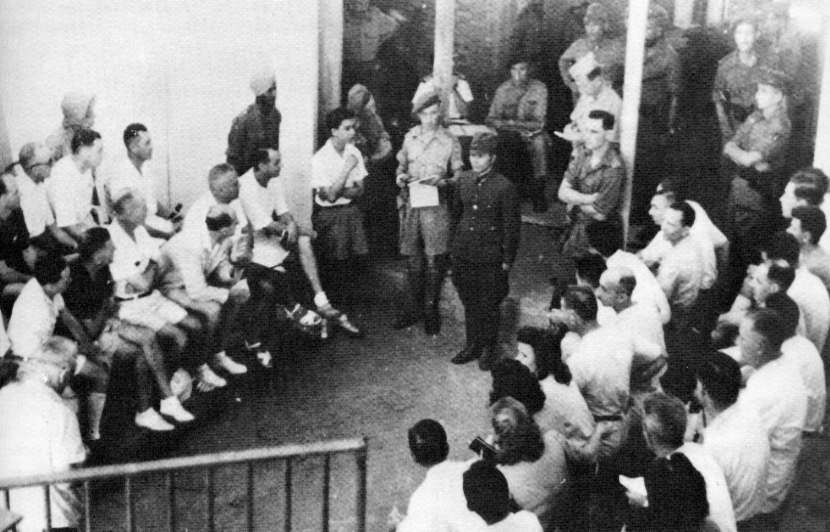
Under British command, former
French prisoners confront their former Japanese captors
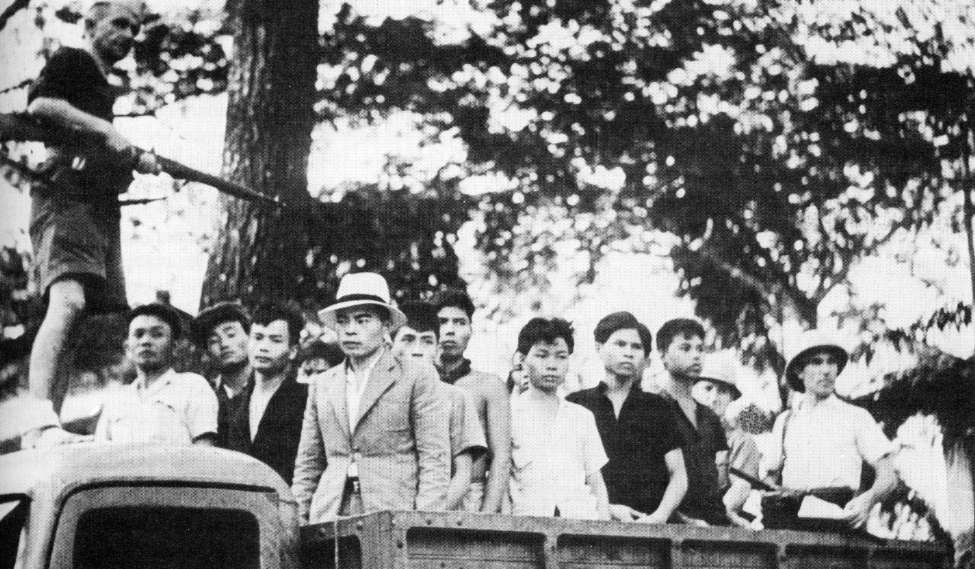
Vietnamese nationalists in
Saigon taken prisoner by the French - September 1945
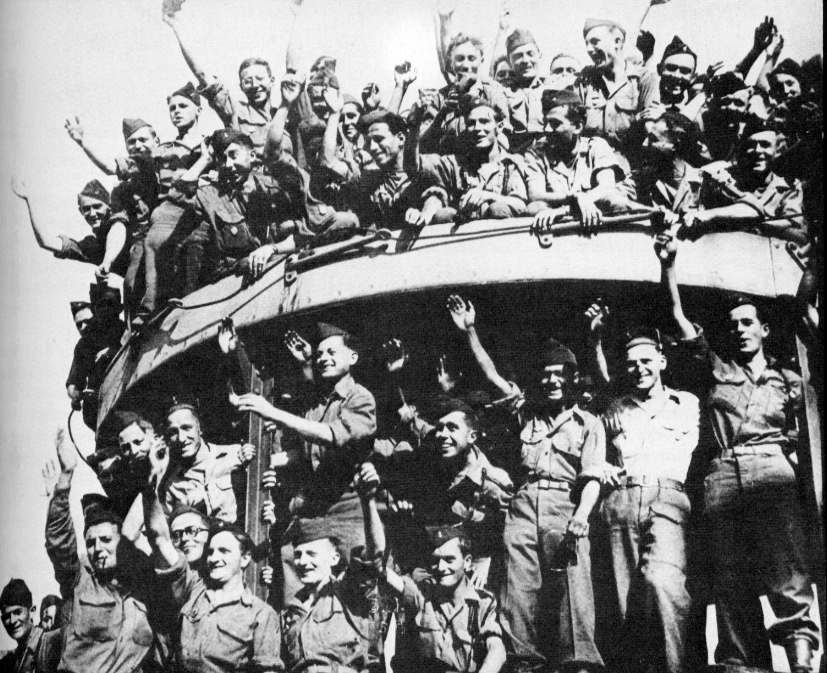
French troops leaving Marseilles
France for Indochina to retake control of the French colony -
November
1945
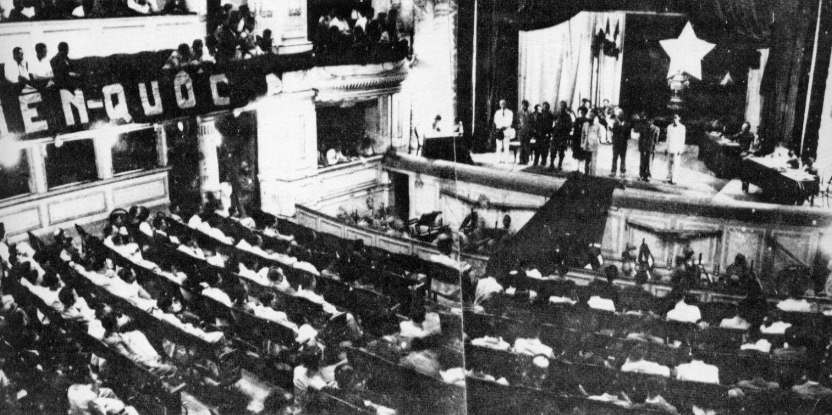
The first National Assembly
of the Democratic Republic of Vietnam meeting in January 1946
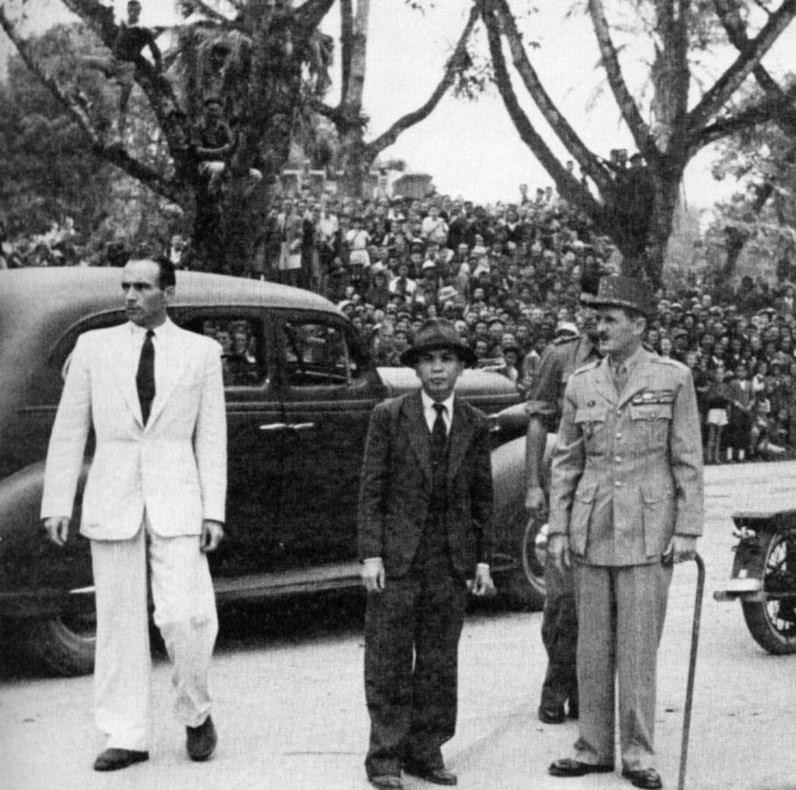
French Commissioner of Tonkin,
Jean Sainteny; Vo Nguyen Giap, Ho Chi Minh's Minister of the Interior; and General
Jacques Philippe Leclerc, commander of the French forces in the Far East, lead a contigent
to the Tomb of the Unknown Soldier in Hanoi, March 1946
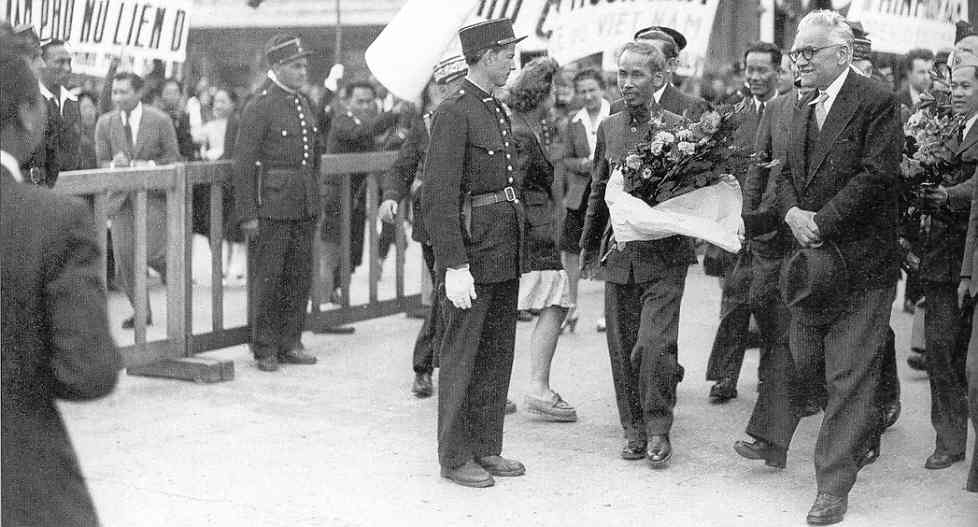
Ho Chi Minh arriving in Paris
to discuss Vietnamese independence
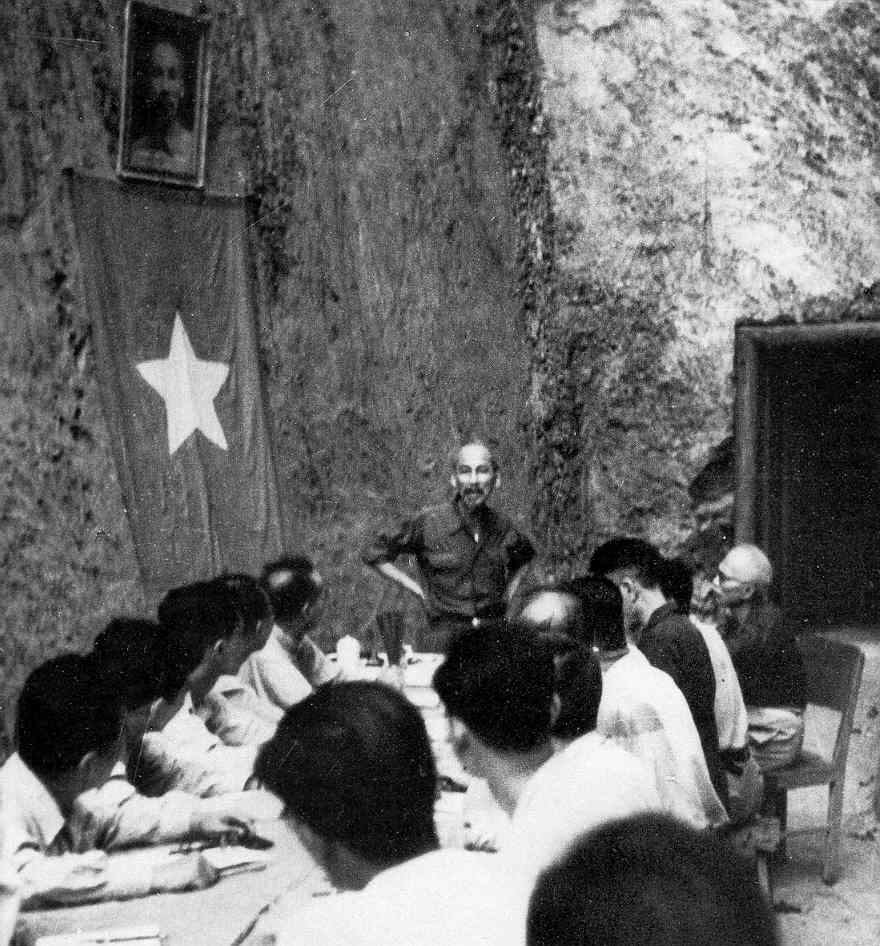
In a cave north of Hanoi,
and under a portrait of himself, Ho Chi Minh meets
council
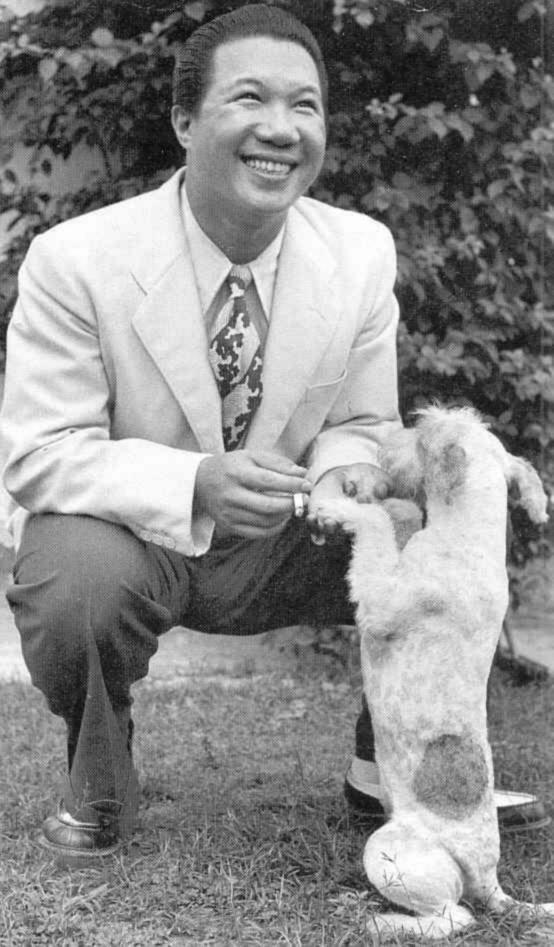 The Vietnamese Emperor Bao
Dai – in exile in Hong Kong – 1948. He was returned to Saigon
in 1949 in a French effort
to form a new non-Communist
government
The Vietnamese Emperor Bao
Dai – in exile in Hong Kong – 1948. He was returned to Saigon
in 1949 in a French effort
to form a new non-Communist
government
MAO TAKES CONTROL IN CHINA |
At
war's end in 1945, Chiang Kai-shek's government faced a serious
problem: the loss of deep esteem in the eyes of the Chinese
themselves. The failure of his Nationalist or Kuomintang army to
stop the Japanese takeover of the highly urbanized coastal regions of
China – and having to rely on foreigners (principally the Americans)
and local warlords – were matters of deep shame in the Chinese
political honor code. To most Chinese, such failure indicated Chiang's
loss of the sacred Tianming (Mandate of Heaven), that is, the powers of
Heaven that Chinese dynasties traditionally built their moral and thus
political foundations on.
Meanwhile Mao and his Communist troops, who had retreated deep into the
Chinese rural interior, had carefully avoided serious engagement with
the Japanese, merely conducting local hit and run tactics … thus not
tarnishing their reputation. Of course that was of little help to
Chiang in his struggles with the Japanese. But Mao knew exactly
what he was doing. He had built up his political reputation
considerably in the world of rural China … at the same time that Chiang
had lost that reputation in the world of urban China – formerly
Chiang's power base.
Also, the huge inflation that hit China at the war's end destroyed the
life savings of that same urban middle class … making Chang's inability
to bring it under control – as any political leader was expected to do
– weaken even further his all-important urban support.
Then too, Mao promised his peasant followers that, once in power, he
would confiscate the large holdings of the Chinese landowners, and
distribute their lands to the peasants as their own personal property …
making Mao very popular among rural Chinese.
There were attempts at war's end to bring Mao and Chiang together in
some kind of political settlement – especially by U.S. General George
Marshall, sent to China for that express purpose. But Chiang
hated Mao deeply. And Mao sensed that he had the political future
on his side. And Stalin, although he supposedly supported the
Allied-recognized government of Chiang, did the same thing as the
Japanese had done in Dutch Indonesia and French Indochina: see
that surrendered Japanese weapons fell into the right hands. And
for Stalin, that meant Mao … not Chiang. And having been given
occupational rights in the vital province of Manchuria, Stalin turned
as much as he could of the area of Manchuria over to Mao.
Meanwhile, the Americans airlifted thousands of Chiang's Nationalist
troops into eastern Manchuria to "balance" the picture. But
beyond that, there was little that the Americans felt that they could
do to improve the situation for Chiang. They were quite aware of
how bad things were for Chiang. And choices would have to be made
… and the "Realist" Truman and his advisors6 were keenly aware that
American interests in European recovery were far greater than those
they held for China.
Step by step, China found itself caught in a widening civil war … with
Chiang on the retreat widely across the countryside and Mao continuing
to build the size of his army and its holdings of Chinese
territory. Then by 1948, Mao was ready to take on urban China,
one city after another falling to Mao's Communist troops. In the
time period alone running from early December to late January, numerous
cities fell to the Communists, including the key city of Beiping
(Beijing). And by April, Mao's troops were able to capture the
Republic's capital of Nanjing … forcing Chiang and what was left of his
army to retreat south all the way to Canton. From there (and
other places) some two million Chinese were able to escape the Chinese
mainland and make their way to the island of Taiwan.
On October 1st (1949), Mao announced the creation of the new People's
Republic of China … bringing China fully into a Russian-American Cold
War that was well underway by that point. The Soviet Russians
would give full support to Mao's China … whereas America (and its
allies) would continue to support Chiang as the only legitimate voice
of China – even though his political base was now located at Taipei,
the capital of Taiwan.
6Truman’s
small society of foreign policy advisors was outstanding: besides
George Marshall, Dean Acheson, Robert Lovett and George Kennan, the
list included Chip Bohlen, Averell Harriman, Paul Nitze, John McCloy
and many other highly talented American statesmen. Most of these
men served as advisors in some capacity from the Roosevelt
Administration in the 1930s all the way to the Johnson Administration
in the mid-1960s.
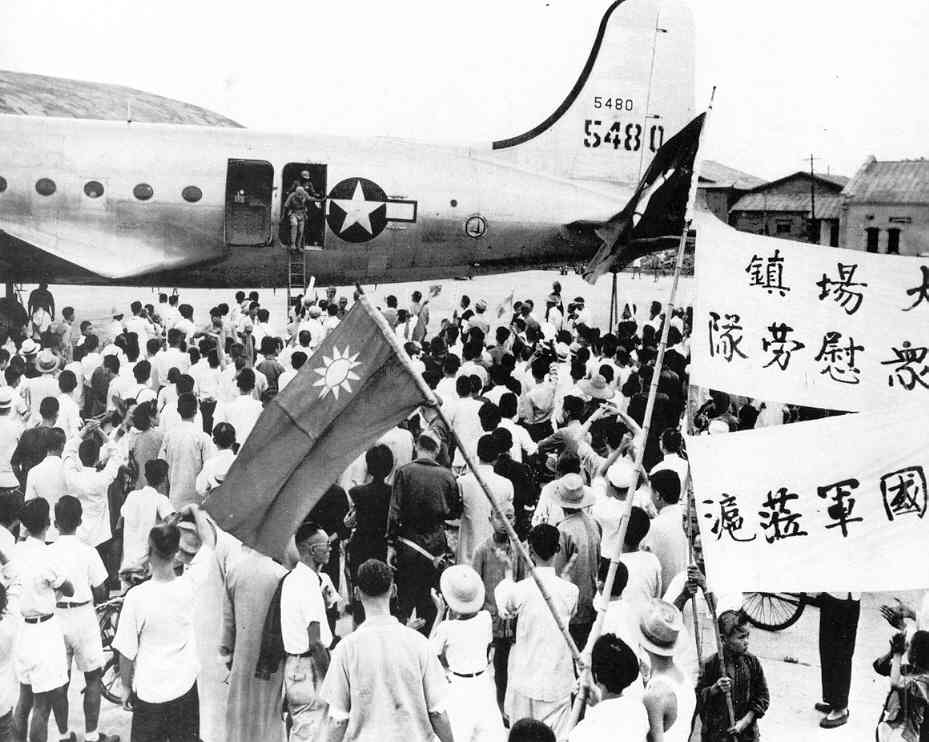
US C-54 plane transporting
Nationalist troops to Shanghai - October 1945
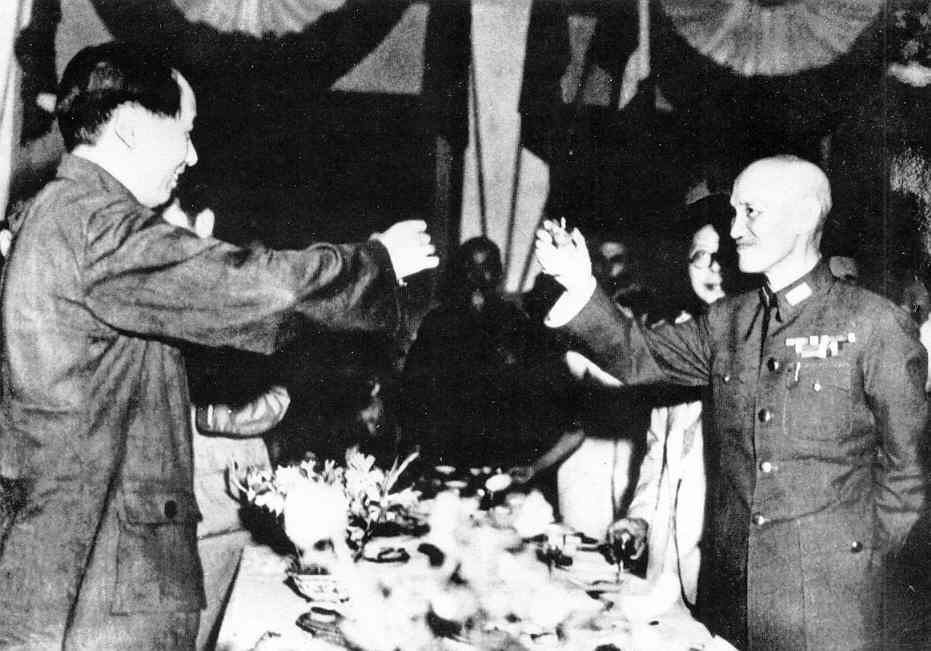
Bitter foes, Mao Tse-tung
and Chiang Kai-shek, putting on smiles at a reconciliation
conference called by the United States
in August and September of 1945
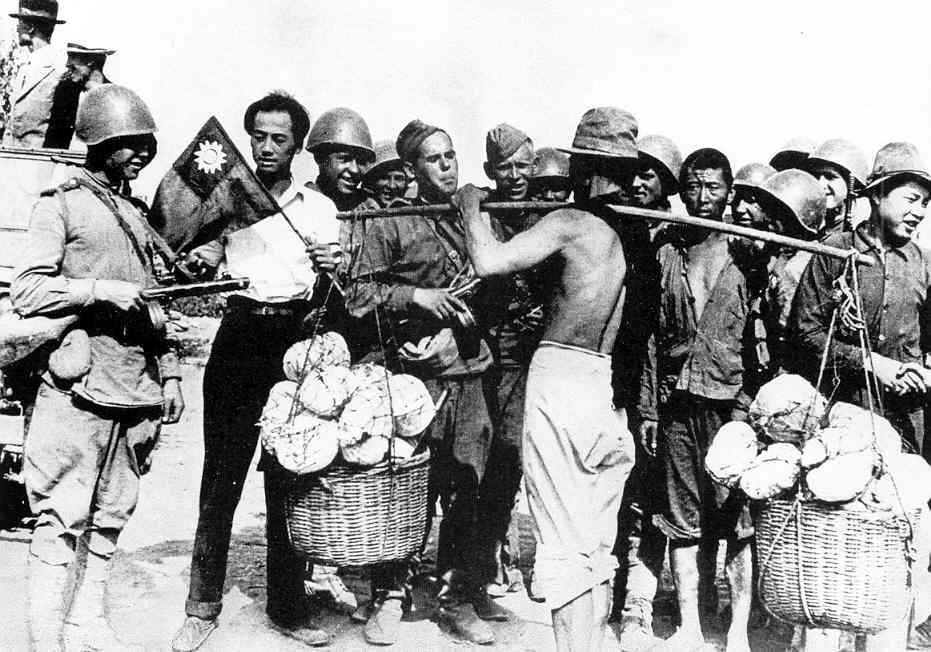
Russian soldiers, who entered
the war against Japan a week before Japan's surrender, mixing with Chinese
in Manchuria, which they have just taken over from the Japanese - 1945
Fotokhronika-TASS,
Moscow
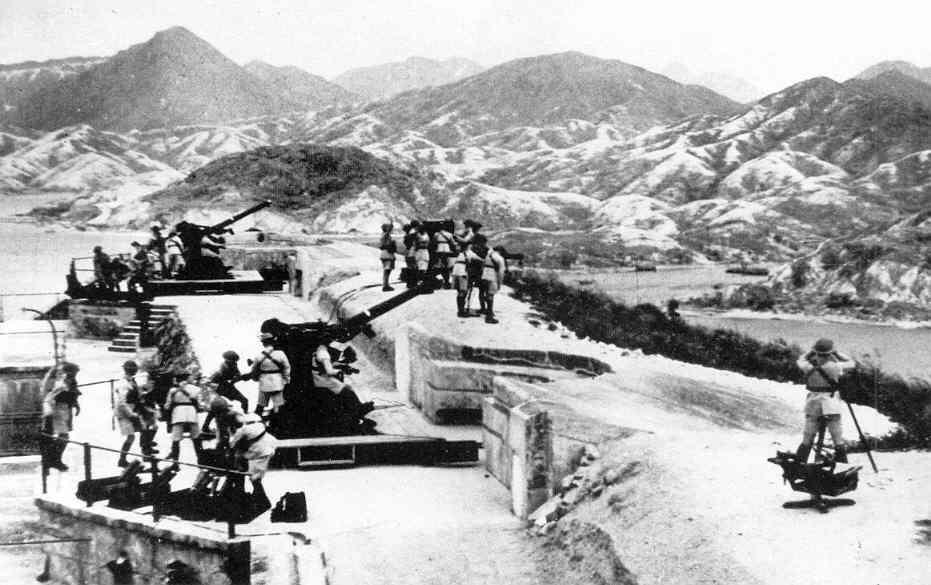
The British were quick to
retake the valuable Hong Kong colony after Japan's surrender in 1945
National Archives
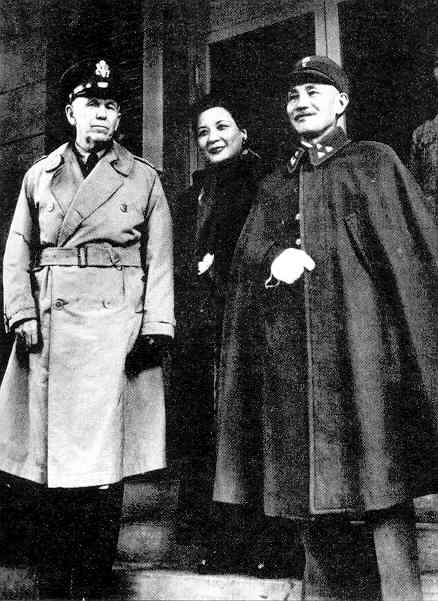
Gen. George Marshall meeting
in Nanking in 1946 with Generalissimo and Madam Chiang Kai-shek in the hopes of negotiating
a peace settlement between the Nationalists and Communists
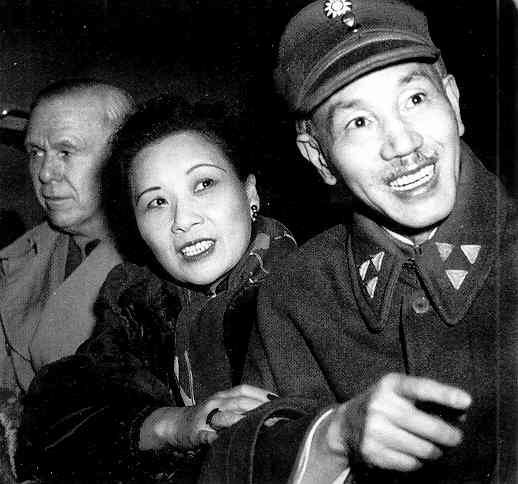
Generalissimo Chiang Kai-shek
and his wife with General George Marshall
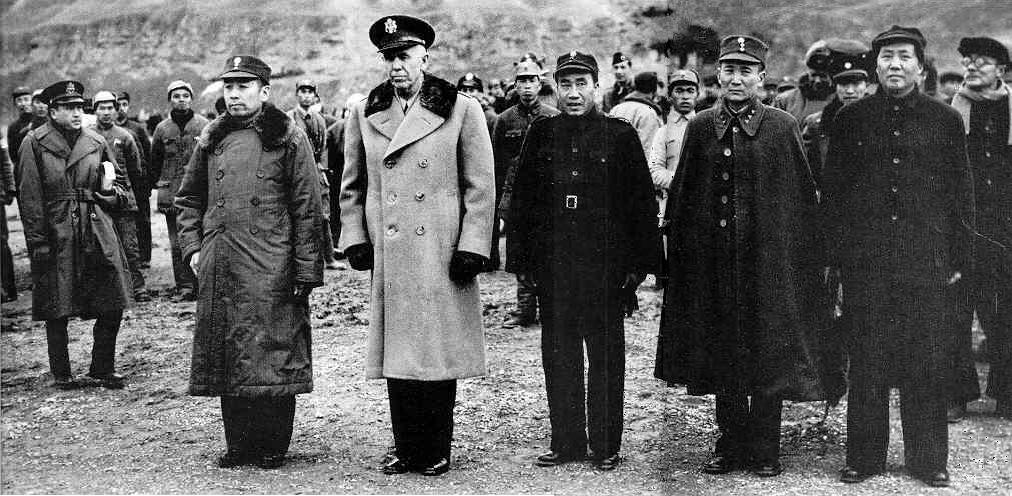
U.S. Gen. George Marshall
brings together the Nationalists and Communists - March 1946 (Communist Chou En-lai,
Gen. Marshall, Communist Gen. Chu Teh, Nationalist Gen. Chang Chih-chung
and Communist Mao Tse-tung)
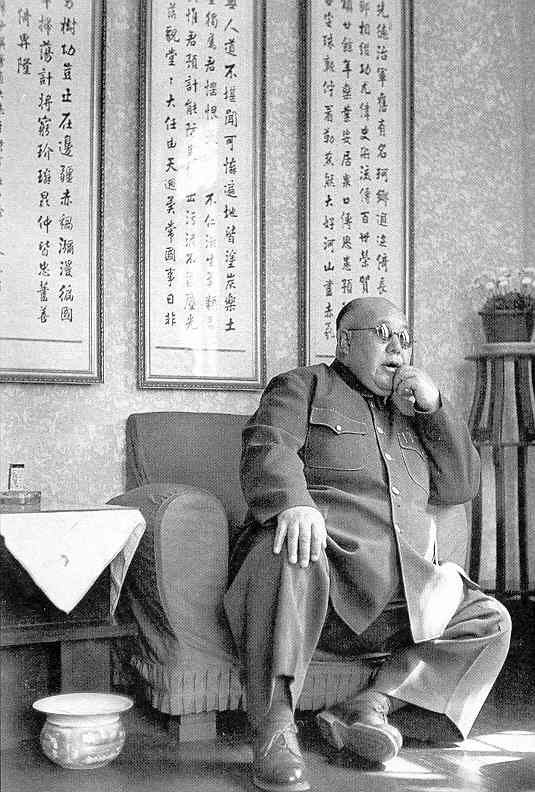
Chinese warlord Ma Hung-kuei
- powerful ally of Chiang's
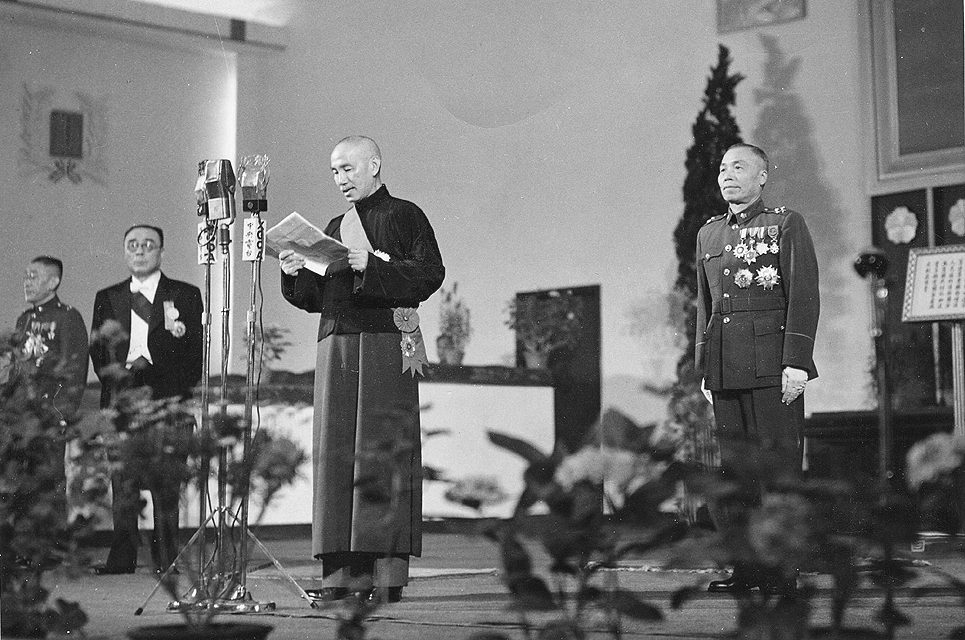
Chiang Kai-shek being declared
President of China - 1947
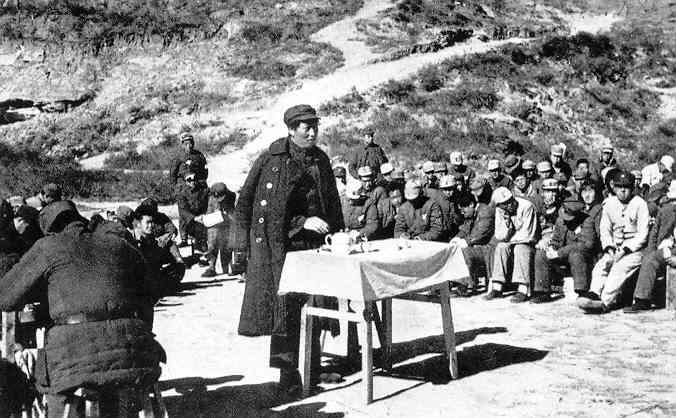
Mao Tse-tung addressing his
followers as his move to oust Chiang
Kai-shek gathers momentum - December 1948
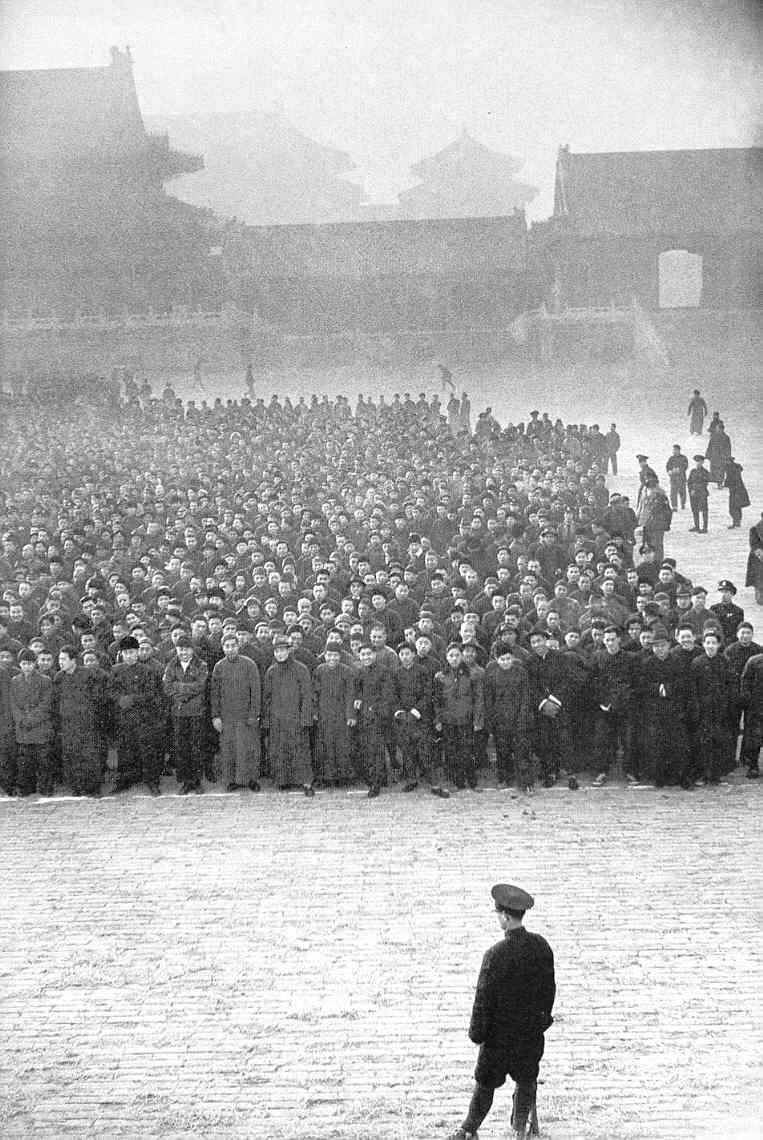
Conscripts for the Nationalist's
last-ditch stand in Beijing against the Communists - December 1948
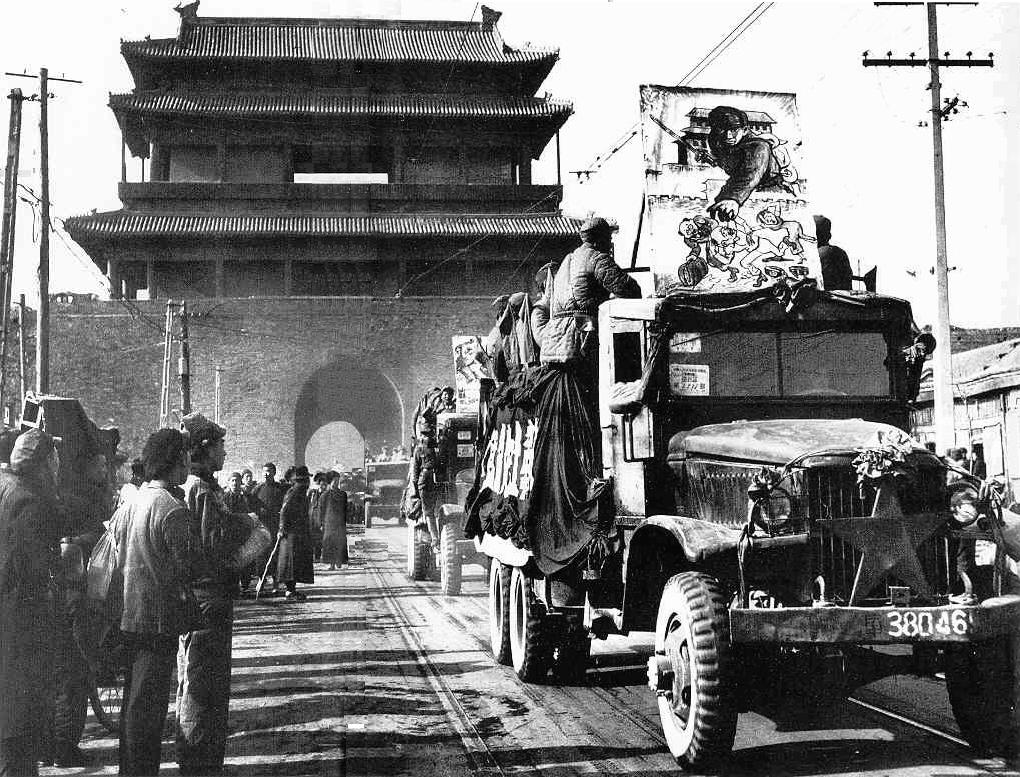
Chinese Communist troops
entering Beijing - February 1949
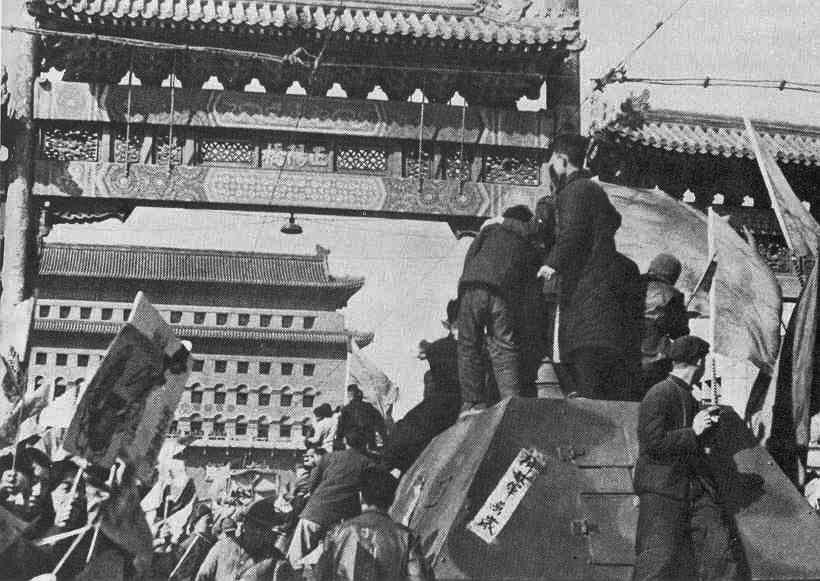 The Communists take over
Beijing – 1949
The Communists take over
Beijing – 1949
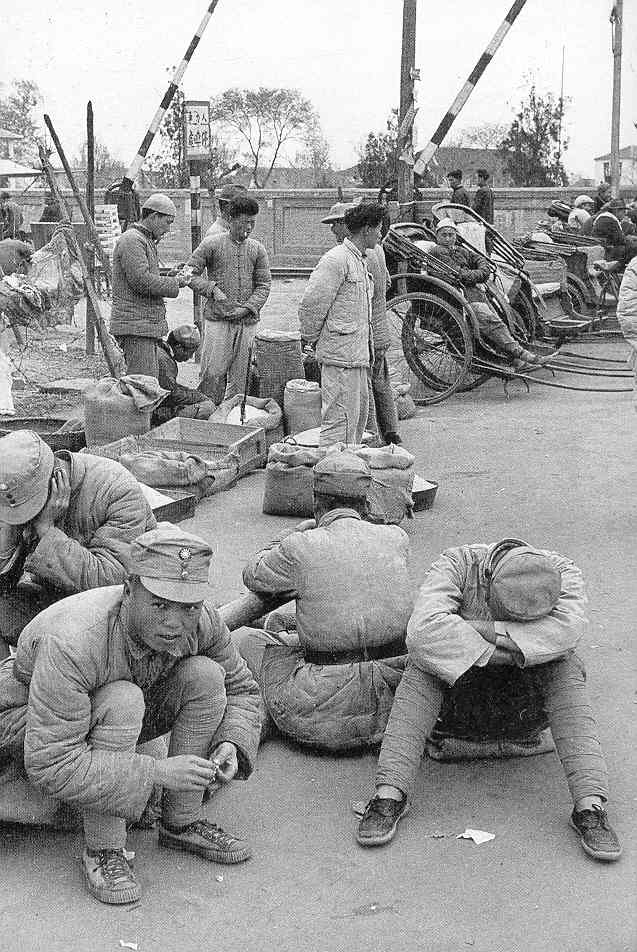
Dejected Nationalist soldiers
awaiting transportation out of Nanking
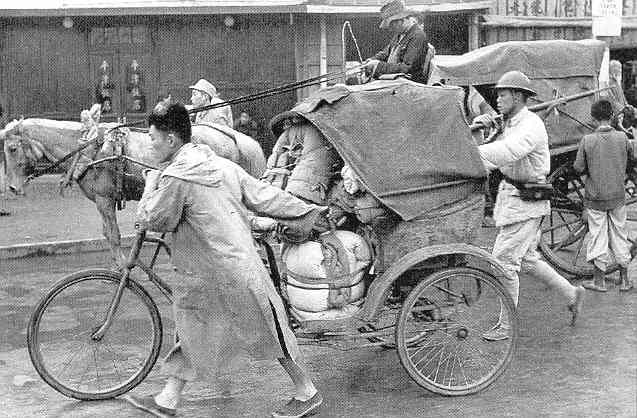 Nationalist Chinese fleeing
Nanking - 1949
Nationalist Chinese fleeing
Nanking - 1949
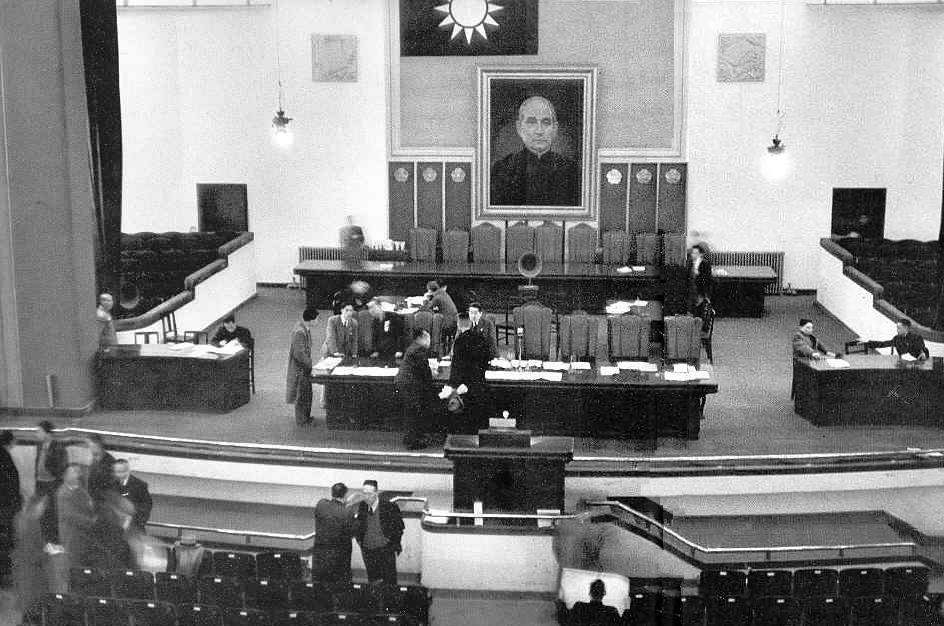
Beneath a portrait of Sun-Yat-sen
the Nationalist parliaments ends its last session - shortly before the Communists
take over Nanking - April 1949
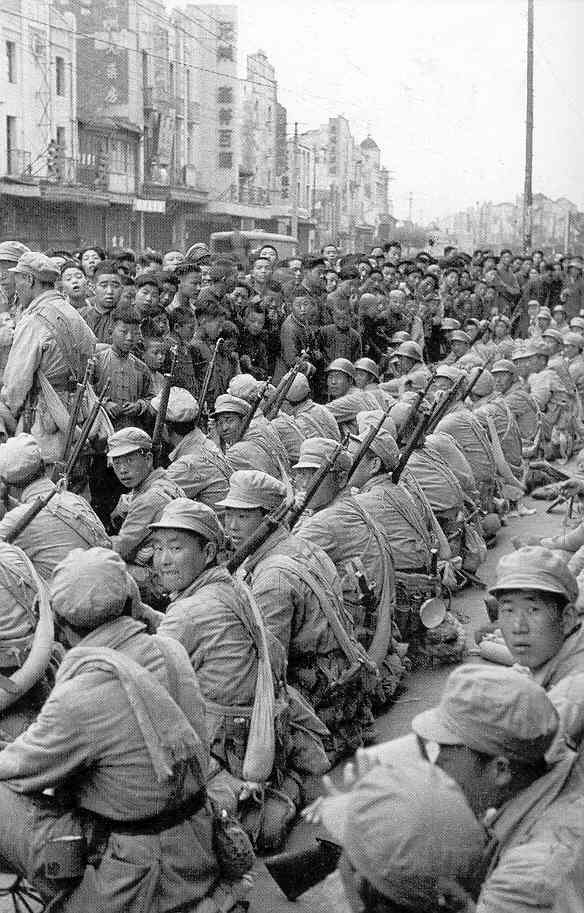
Curious citizens of Nanking
getting their first look at Communist troops
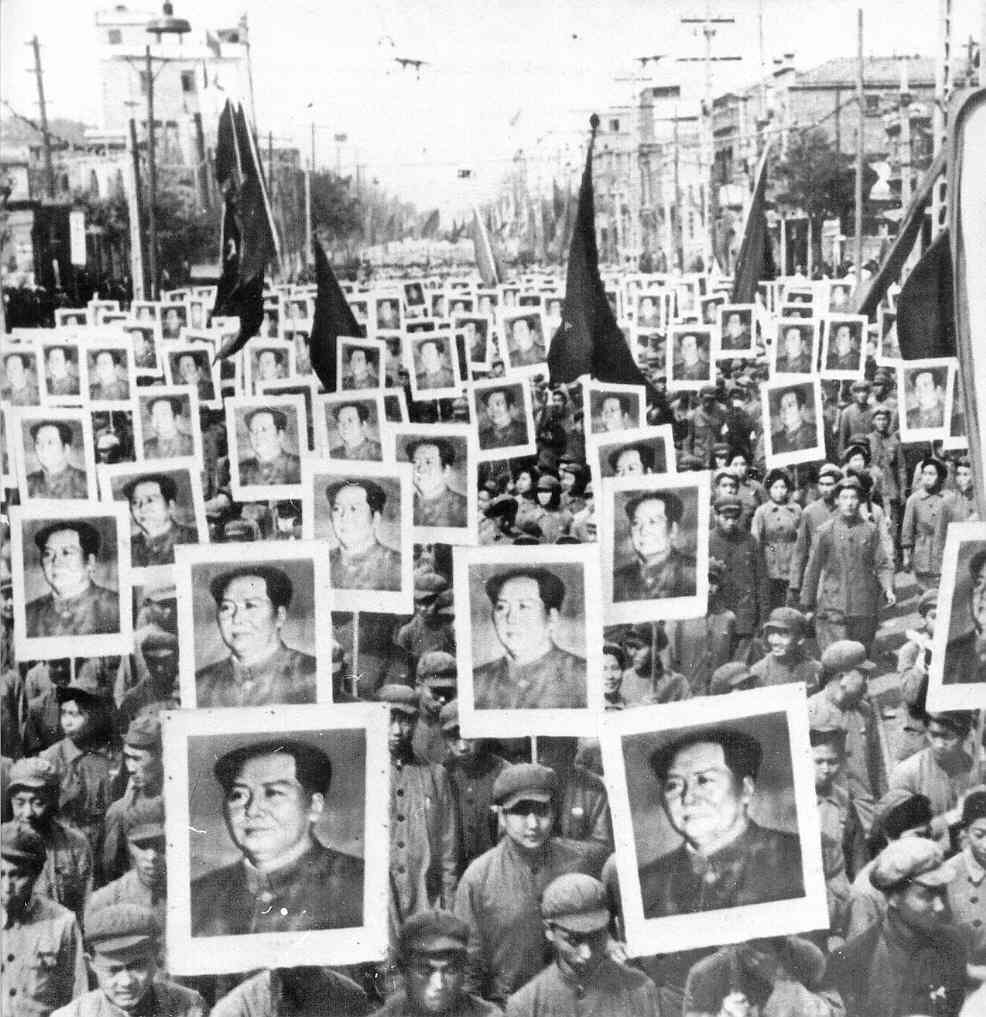
Mao's Red
Army
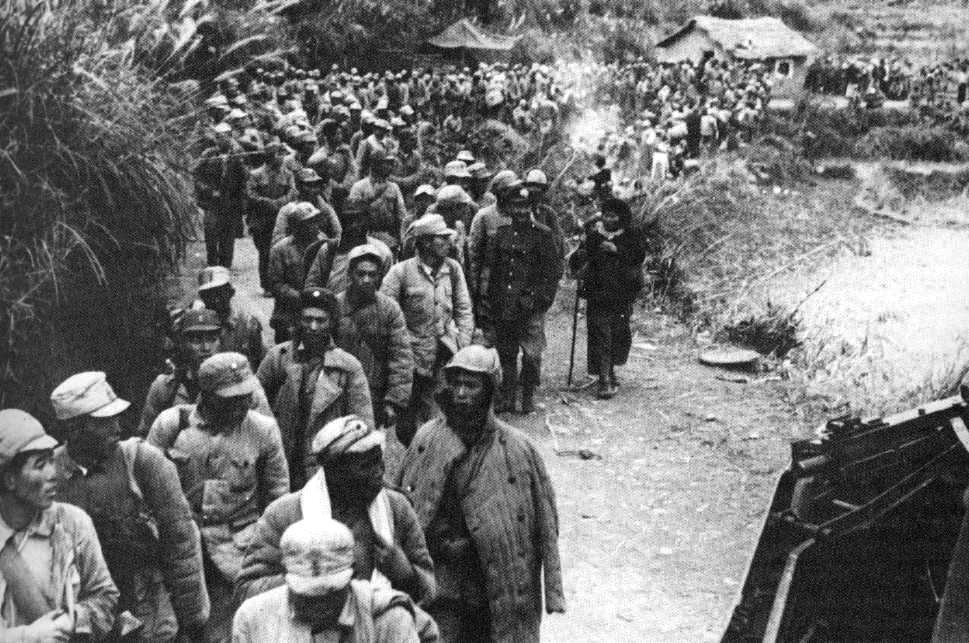
Some of Chiang Kai-Shek's
Nationalist Chinese troops streaming across the border
into northern Vietnam
– 1949
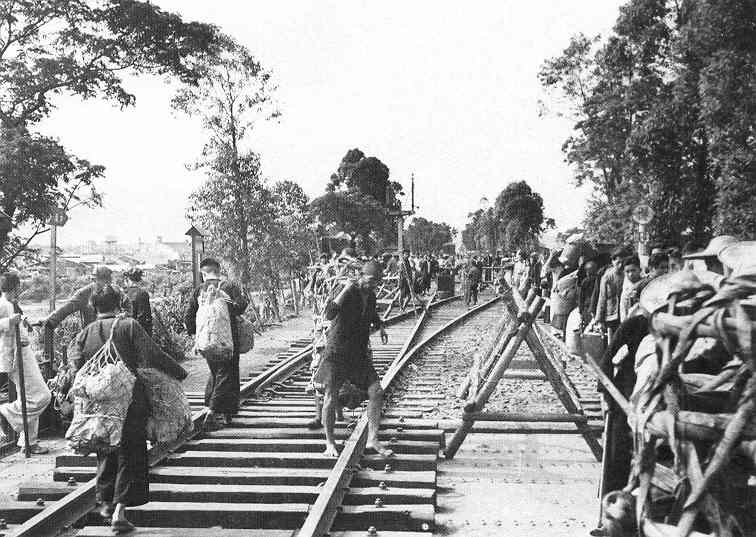
Chinese refugees (at right)
stream into Hong Kong from China in 1950 – passing others going the
opposite direction
THE ISRAELI-PALESTINIAN QUESTION |
The
region known variously as Palestine or Israel has long been sacred to
three major religions … religions seldom in agreement about matters –
but especially about the matter of which of those religions does this
vital area belong to. To the Jews, this is their homeland, the
place of birth of their very religion. To the Christians, this is
where their Lord and Savior Jesus was born, raised, taught, died and
was resurrected as the birthing of their Christian religion. And
to the Muslims, Jerusalem is the third most holy city in all of Islam …
because (among other things) of the nighttime ride of their founding
Prophet Muhammad in and around Jerusalem. And basically, it has
been the Muslims (minus the brief period of the crusades) that have
been the victors in this debate since the 600s.
But the Great War changed matters … deeply. When the Ottoman
Turks joined Germany in that war, they decided the fate of both Islam's
political presiding Ottoman Sultan and its religiously presiding
Ottoman Caliph. As losers in that war they lost to both a modern
Britain abroad and a modernizing Turkish leader Atat rk at home …
leaving Islam headless – and the Holy Land of Palestine in British
hands as its mandated "protector."
Actually (as already noted), problems had already begun to arise a bit
earlier when persecuted Jews decided to leave Europe (late 1800s and
early 1900s) and head to their holy homeland, "Zion." Thus the
Zionist Movement was born.
The Palestinian issue was not, however, a religious matter … but simply
one of property rights … at least not originally. Something
resembling religious toleration had actually long existed in the
land. The capital city, Jerusalem, was itself divided into
religious quarters, one Jewish, one Muslim, one Christian, and one
Armenian (but also Christian). And relations among those groups
tended to be friendly … if not a bit distant.
Most unsurprisingly, immigrants coming from Europe to Palestine found
the region fully occupied. The only uninhabited areas where
Zionists could possibly settle were basically desert.
True, Zionists did set up numerous small communities (Kibbutzim),
sustained by channeling water from the Jordan River – which flowed
right through the middle of that desert, from the heights of the
mountains in the north to the Dead Sea in the south. But this
method could support only small numbers of those trying to settle in
Palestine ... and would also drain down the river deeply.
But the Zionists also knew that the peasants working the farmlands of
Palestine did not generally own the land. Land-ownership belonged
to wealthy families, living not locally – but off in one or another
city. So the Zionists used funds to purchase that land from these
absentee landlords … and then remove the Palestinian peasants working
the lands in order to make way for Jewish settlers. Needless to
say, this stirred up considerable anger … and the beginning of an
ongoing war over the land (much like the one between the Indians and
the European settlers in America).
Then during the Great War, the British took it upon themselves to take
charge of the region, using that position to get various war support
against the Turks … in exchange, promising British support of the
ambitions of one group and then another involved in the Palestinian
question. To the Jews, they promised (the 1917 Balfour
Declaration) to support the idea of a Jewish homeland somewhere in
Palestine … in exchange for much-needed financial support from the
fabulously wealthy Jewish Rothschild banking family of Paris. But
they made a similar offer to local Palestinians … in exchange for their
rising up against their former Ottoman Turkish rulers. And they
made the same offer to themselves … in their own desire to expand their
British Empire into the coastlands of the Eastern Mediterranean – close
to their Suez Canal and the Egyptian government they already had under
British wings.
This triple promise only guaranteed that even greater political
confusion would follow in the postwar years. The bitterness
deepened in Palestine even further in the 1930s when the global Great
Depression upset the economies of people everywhere. In 1936, the
British had to put down a major Arab revolt against the incoming Jews,
leading the Jews to form David Ben-Gurion's Jewish Agency, and the
development of a skilled Jewish army, the Haganah … set up supposedly
to help the British put down the revolt. But the British then
(1939) put in place a 15,000-person limit to Jewish immigration into
British Palestine … deeply upsetting the Jewish world which was
suffering from the intense Nazi persecution of Jews in Europe.
But even 15,000 new settlers coming into Palestine annually would mean
a somewhat similar number of Palestinians displaced from their homes
and lands.
Then World War Two hit … and much of the movement was blocked by military developments.
But after the war, the situation would become explosive … on a
monumental basis. Opening the Nazi concentration camps put muscle
behind the Zionist movement … that plus the reluctance of others, even
those who had themselves suffered under the Nazis, to receive the Jews
back to their homes (Poland was highly problematic in this
regard). Thus tens of thousands of Jews became determined to
reach a place of greater security, a place they could truly call their
Jewish homeland.
But the British were caught in the middle … with not only their Arab
friends furious that the British would allow this mass migration (the
British were actually doing all they could to slow down the movement) …
and getting shot at now by their wartime allies, the Jewish Haganah –
and the Jewish terrorist organizations, Irgun and the Stern Gang (or
Lehi). And this came at a time when the British Prime Minister
Atlee was doing everything he could to get Britain out of its
international commitments ... so that it could focus on problems at
home. Thus the decision was finally announced in London (February
1947) that Britain was turning the matter over to the new United
Nations … and would be getting out of Palestine as soon as possible.
But the new U.N. found itself in no better of a place than the British
in taking on this political challenge. Efforts were made to
divide Palestine into distinct Arab and Jewish territories, the
foundations for future states. But neither party was willing to
give up its goal of holding the entire region … and thus the fighting
merely worsened.
At this point Britain announced that it would be leaving the area as of
May 14th 1948. This it did … and on that same day the Jews
announced the establishment of the Jewish state of Israel. Both
Soviet Russia and America were quick to recognize the new government.
But this did not mean the end of the fighting … for all of the Arabs,
including those of the surrounding states, refused to recognize the
State of Israel. And thus the fighting merely intensified.
And it also meant the disregard by the Jews of even the borderlines set
out by the U.N. in its proposal to divide Palestine into two states.
Meanwhile Palestinians fled the scenes of battle, especially after the
rumor spread rapidly of the massacre of an entire Palestinian village
(Deir Yassin) by Jewish terrorists. And the Mediterranean coastal
city of Jaffa – supposedly designated by the U.N. plan to be included
in the new Palestinian state – was terrorized by Irgun and Lehi7 ... and
the city's Arab population of 70,000 was soon reduced to a mere
4,000. And across the countryside, some 700,000 Arabs that had
fled their homes would find themselves blocked by Israeli authorities
from returning to their homes – despite a U.N. resolution calling on
Israel to allow them to return to their homes. Instead, the
refugees would have to take "temporary" residence in UN-run refugee
camps … camps which would in fact become permanent homes to a huge
Palestinian society unable to take care of itself (these camps were
mostly located on desert land).
No soil for farming, no jobs of any kind, no hope at all awaited these
lost Palestinians. This was perfect material for a long and
lasting Arab-Israeli conflict.
7It
is interesting to note that the Irgun leader Menachem Begin, who
ordered the destruction of the King David Hotel (and 91 lives,
including even Jews as well as British and Arabs) would become Israeli
Prime Minister in 1977... and ironically become winner of the Nobel
Peace Prize in 1979. Also a former Lehi leader Yitzhak Shamir
would follow Begin as Israeli Prime Minister in 1983, a man who ordered
the assassination in 1944 of the British Minister for Middle East
Affairs, Lord Moyne, and in 1948 the United Nations peace negotiator,
Swedish Count Bernadotte.
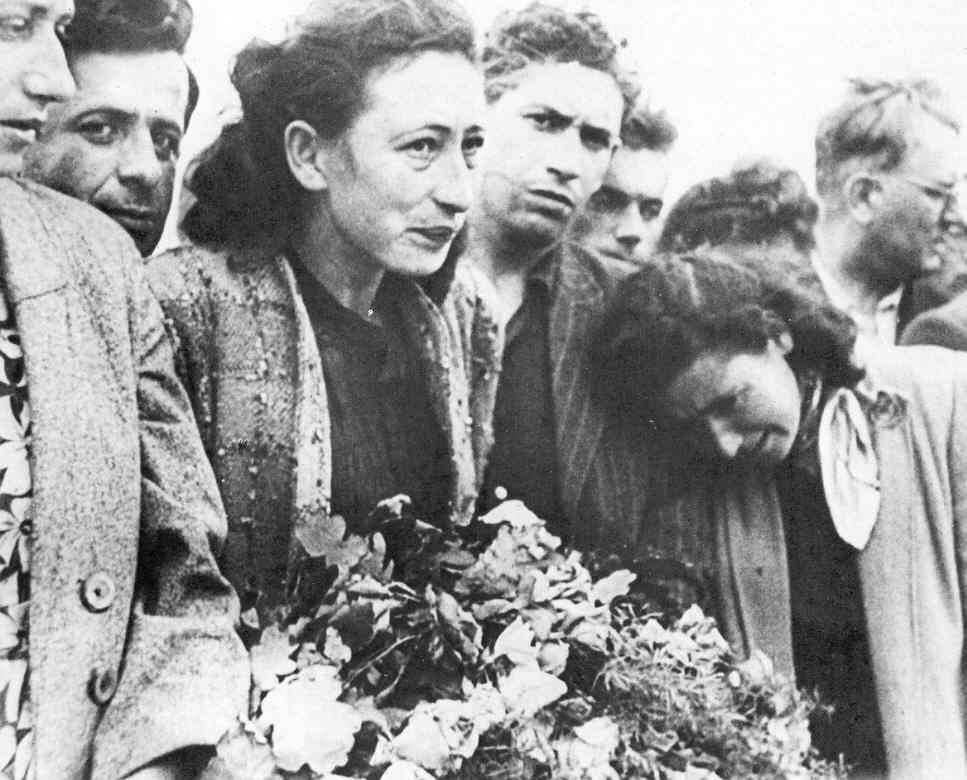
Jews mourning relatives killed
in anti-Semitic violence in Kielce, Poland - 1946. The leaders were tried and convicted;
but this nonetheless persuaded thousands of Jews to emigrate.
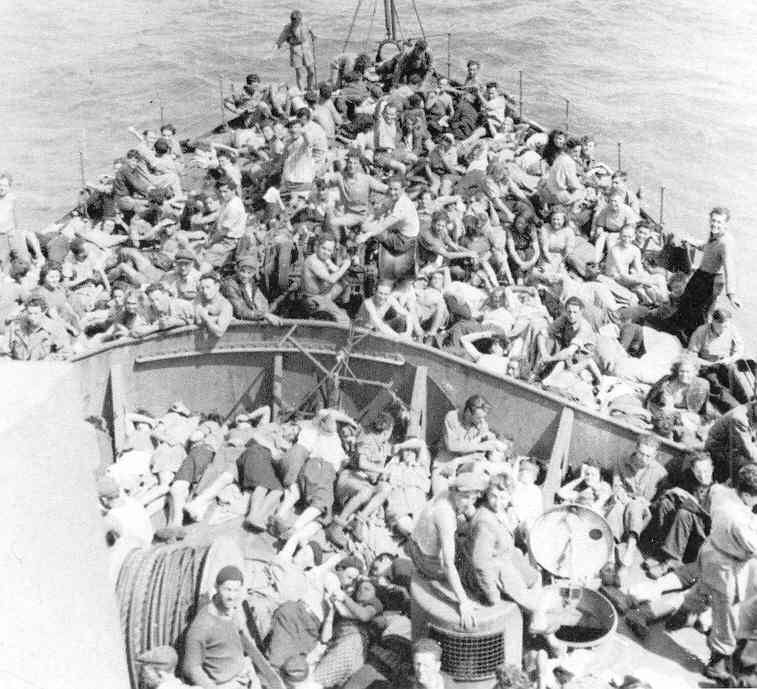
A party of rather young and
very determined Jews sailing to British-held Palestine to start a new life
there - 1946
| 3 million Jews survived
the War ... out of the original 10 million of Europe's original population.
To many – if not most – Jews, an independent Jewish state in Palestine
seemed to be the only guarantee that this would never happen again to their
people. |
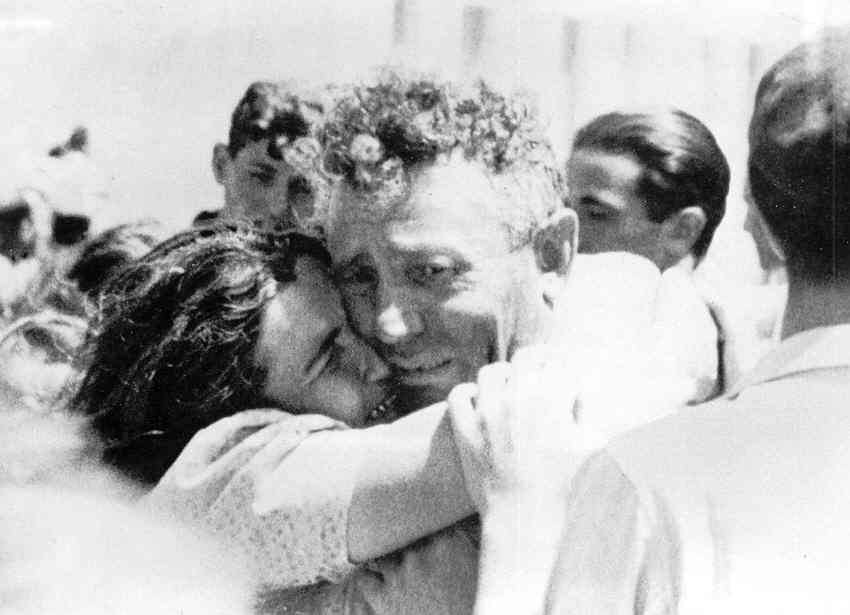
A Jewish husband and wife
- separated by the Nazis since 1941 - reunited in Haifa - May 1946
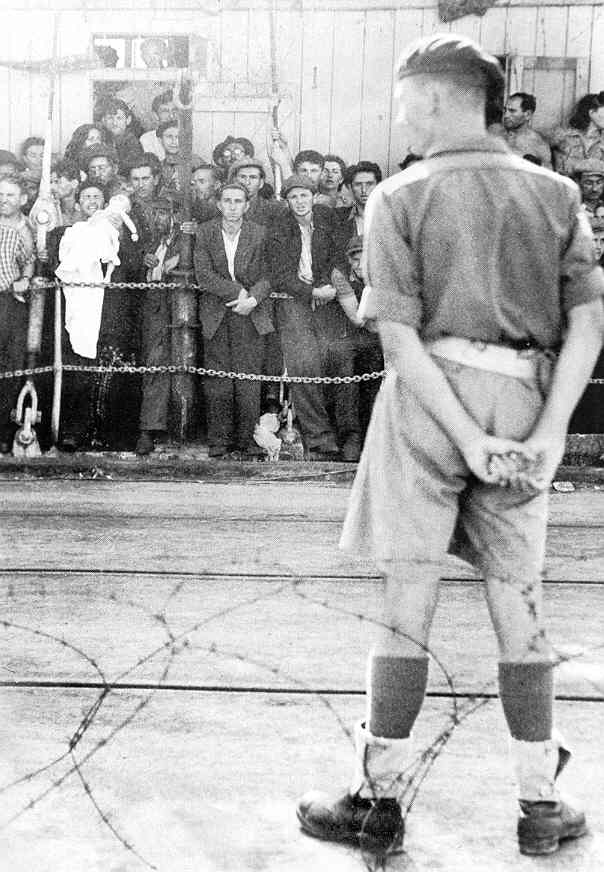
A British soldier at the
Haifa docks guarding Jews barred from entering Palestine
| Fearing a massive
rebellion from
the Arab Palestinians who were irate at the post-War flood of immigrants
into their land, the British began to seriously enforce an immigration
restriction: only 1500 Jews per month. The huge additional flow of
Jews that arrived were at first sent to Cyprus to await their place in
the quota -- a process that promised to be years in the making. Soon
overwhelmed in Cyprus, the British took to returning the Jews to Europe. |

A ragtag Szold being
blocked by British troops from disembarking its passengers into Palestine
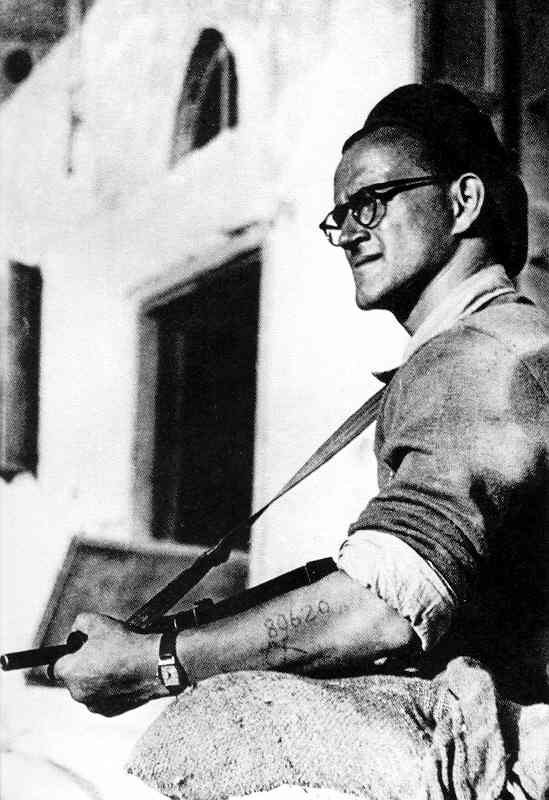
A Haganah soldier
- with Auschwitz tattoo – doing sentry duty in Jaffa
| The 60,000-man army-like Haganah,
led by officers who had fought alongside the British towards the end of
the War, now turned its wrath upon its former ally. The Haganah
blew up British radar stations, sank British boats patroling the Palestinian
coastline, blew up oil refineries, British troop trains, RAF airfields
and bridges, cut phone lines and oil pipelines – and succeeded in
isolating Palestine ... and the British authority overseeing it. |
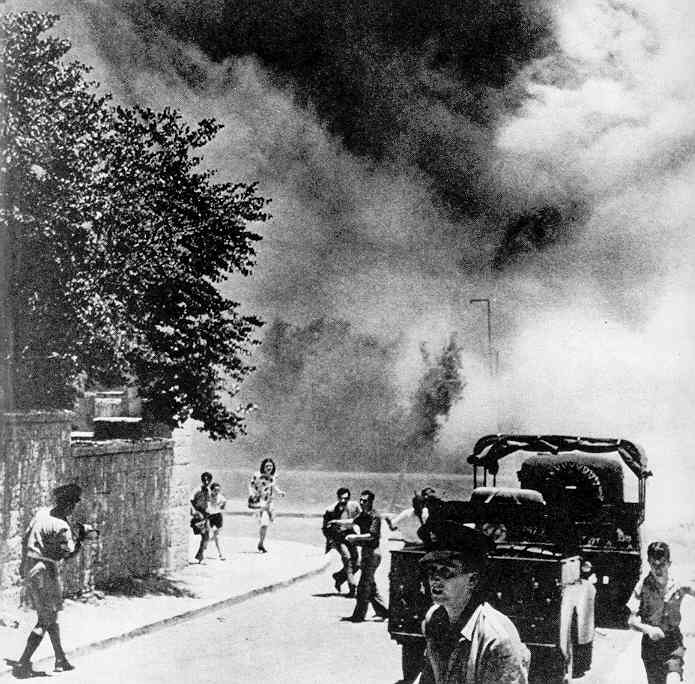
A wing of the King David
Hotel being blown up by the Irgun terrorist organization
- July
22, 1946.
91 Britons, Arabs and Jews died in the
explosion.
| While the
Haganah attempted
to focus on military targets and minimize human casualties, the 2000-man
Irgun
- led by the Polish refugee Menachem Begin - and the much smaller Lehi
or "Stern Gang" worked in quite the opposite fashion. They gunned
down their opponents on the streets, sent letter bombs, dressed themselves
as Arabs or British soldiers in robbing banks, bombing train stations,
attacking police stations and government offices, etc. By the end
of 1946 they had also assassinated 373 people as part of their strategy
of terror. |
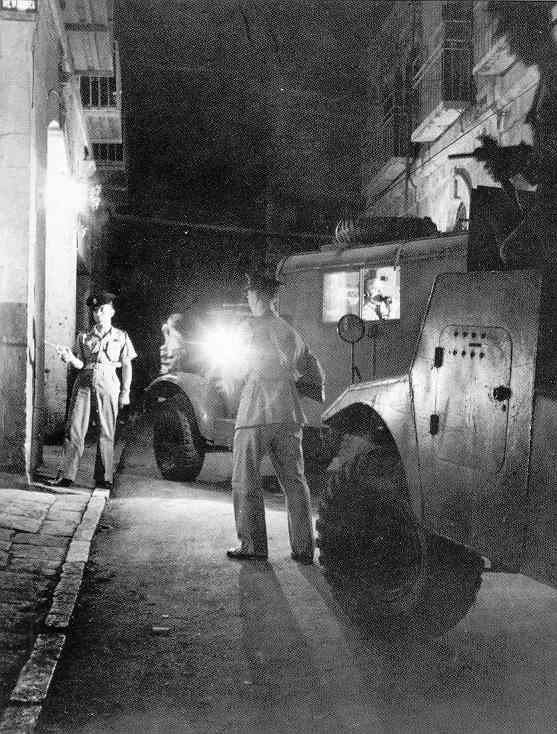
British police about to invade
a suspected terrorist hideout in Jerusalem - October 1946

An Orthodox Jew being searched
before being admitted into a British compound for questioning about the bombing of a British
officers' club by terrorists – on a day (March 1, 1947) in which
16 attacks were
carried out against British targets, resulting in the deaths of 22 people
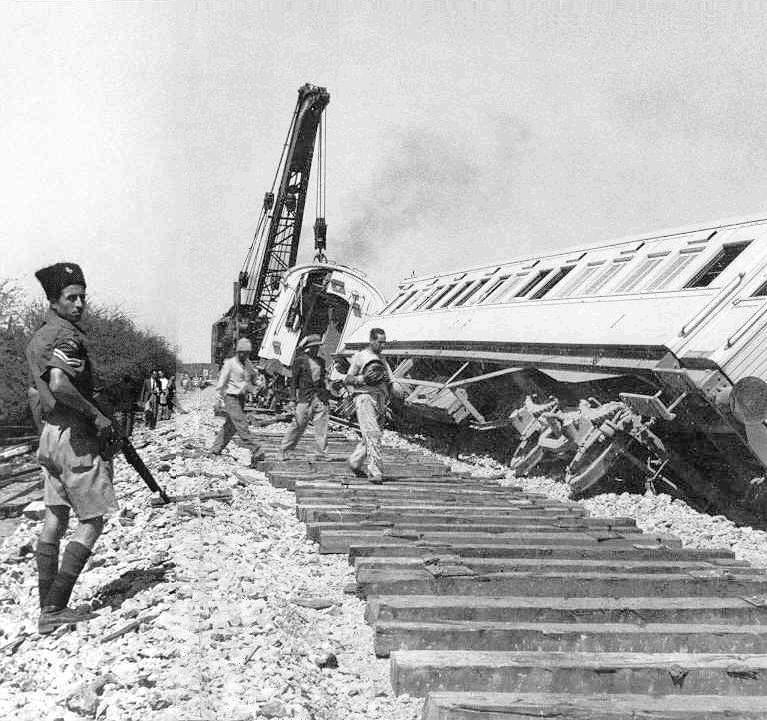
A Palestinian policeman guards
workers clearing wreckage of a train wreck - April 1947
| The Cairo to Haifa
express train
carrying British troops was sabotaged by the Jewish underground, killing
five soldiers and 3 civilians. |
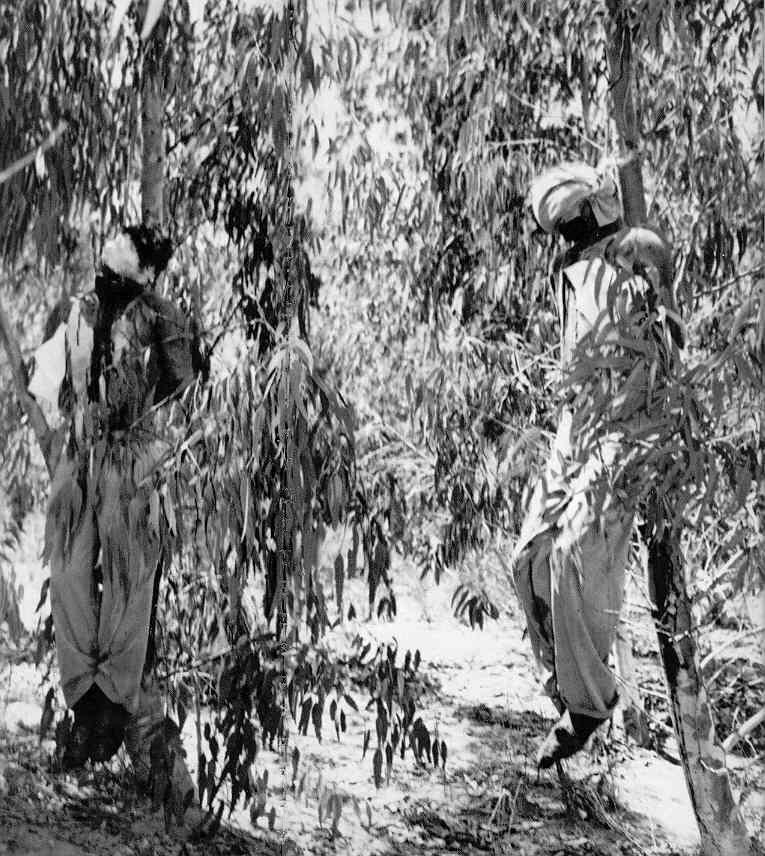
Two British soldiers executed
by the Jewish terrorist organization Irgun - after the British executed
two Jewish terrorists - July 1947
| A copy of the
Irgun's execution
orders is pinned to one of the soldiers. When the first body was
cut down it exploded, wounding a British officer. The Irgun
had mined the surrounding ground. On hearing of this atrocity, off-duty
British troops in Tel Aviv rioted, killing 5 Jews and wounding 15 more. |
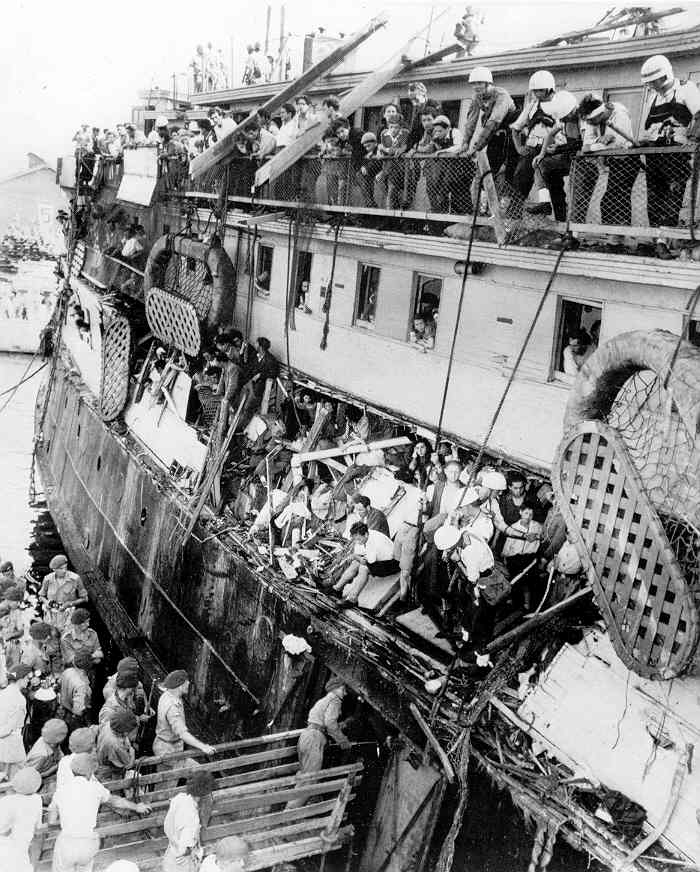
A Haganah refugee
ship Exodus-1947 impounded by the British at Haifa - July
1947
To discourage further
immigation
of Jews, the British decided to make an example of this ship - ramming
and crippling it just outside Haifa - and then transporting its 4500 passengers
back to Europe in three prison ships. |

Defiant young Jews of the
Exodus-1947 being held in the Poppendorf D.P. [Displaced Persons] camp in
Germany
| The British guards at
Poppendorf
were less than enthusiastic about this assignment and the Jews were able
simply to slip away. Within a year the camp was empty -- and the
former detainees finally reached Palestine. |
Violence breaks
out upon the UN decision of November 30, 1947 that Britain's mandate
in
Palestine will end the following Mayand that Palestine will
be divided into two states – with the coastal areas going
to the Jews and the interior and Gaza to the Arabs.
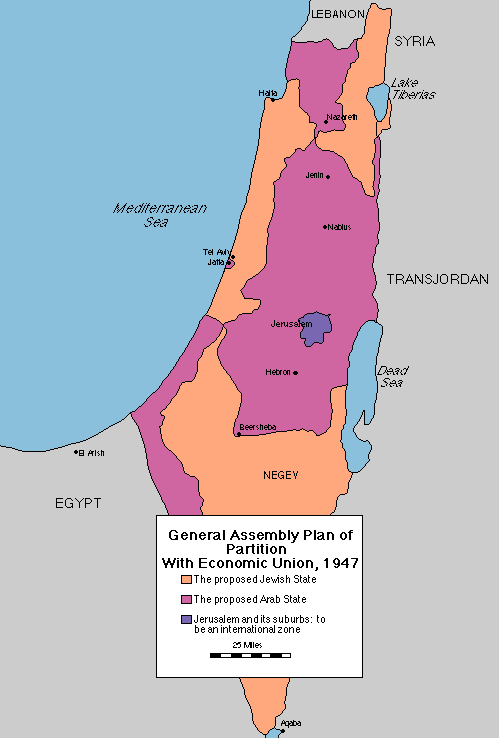
The Jews are elated; the
Arabs are furious. ... what gives the United Nations the right to give Arab
land away
to European Jews? It was the Europeans, not the Arabs, that mistreated the Jews.
Now the Europeans are making the Arabs pay for the European
atrocities.
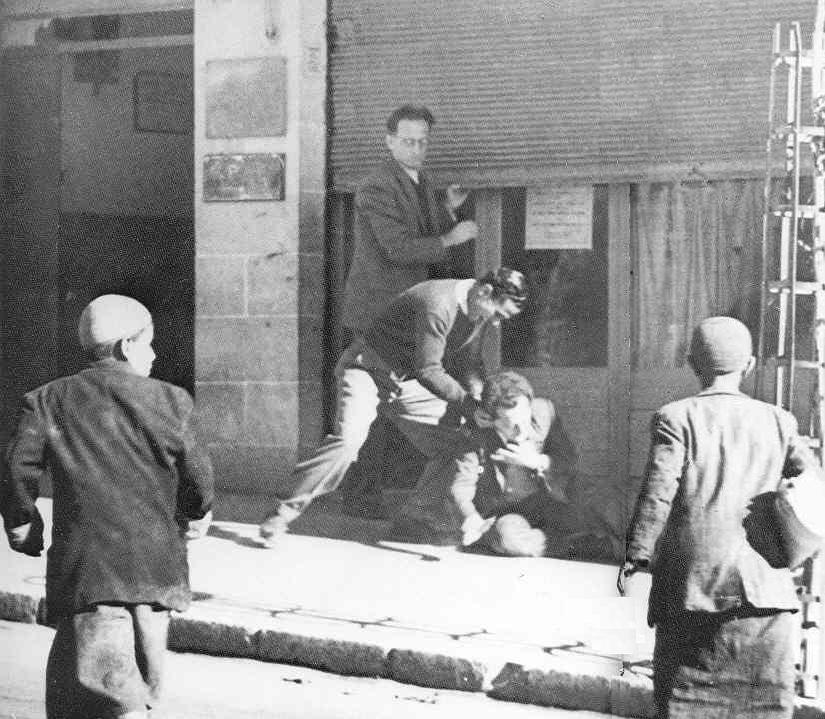
A Jewish journalist stabbed
by an Arab during the riots in Jerusalem that followed the November 30, 1947 announcement
of the UN-sponsored partition of Palestine
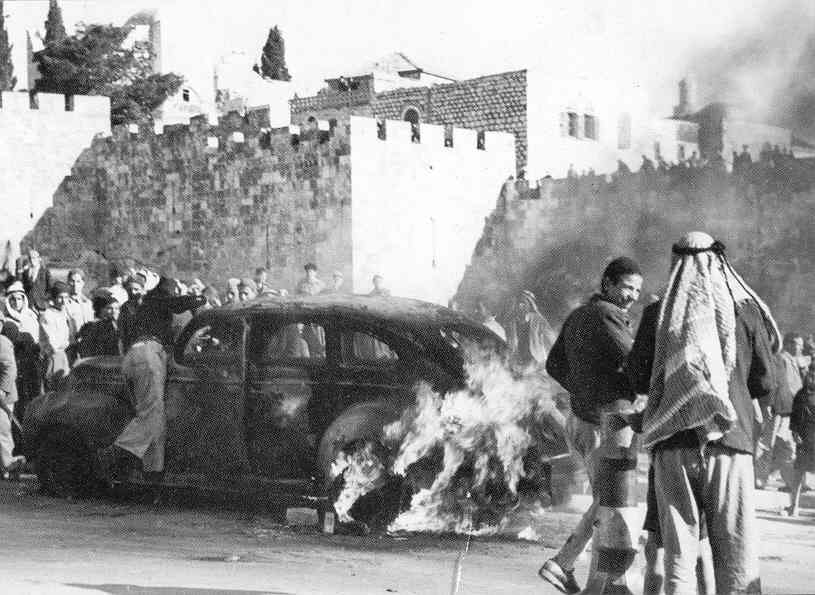
A Jewish-owned taxi burns
outside the Damascus Gate in Jerusalem in retaliation for a drive-by
shooting conducted by Jewish terrorists which killed 15 people in the Arab
market. During the month after
the announcement
of the pending partition,
489 people died in the violence.
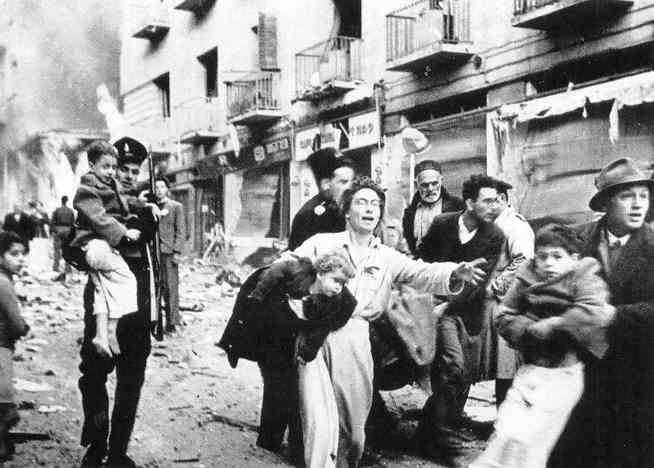
Jews fleeing a bombing of
Ben Yehuda Street in Jerusalem - February 22, 1948
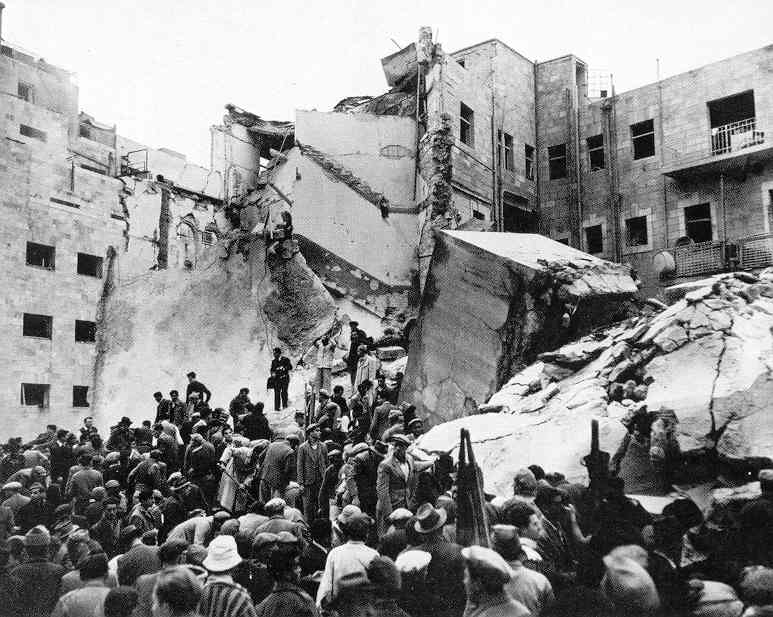
Jews surveying some of the
damage caused by the Ben Yehuda bombing. The bombing
was undertaken
by Arab terrorists dressed up in British uniforms. 57 people died. Angry
Jews, taken in by the deception, killed 9 Britons in retaliation.
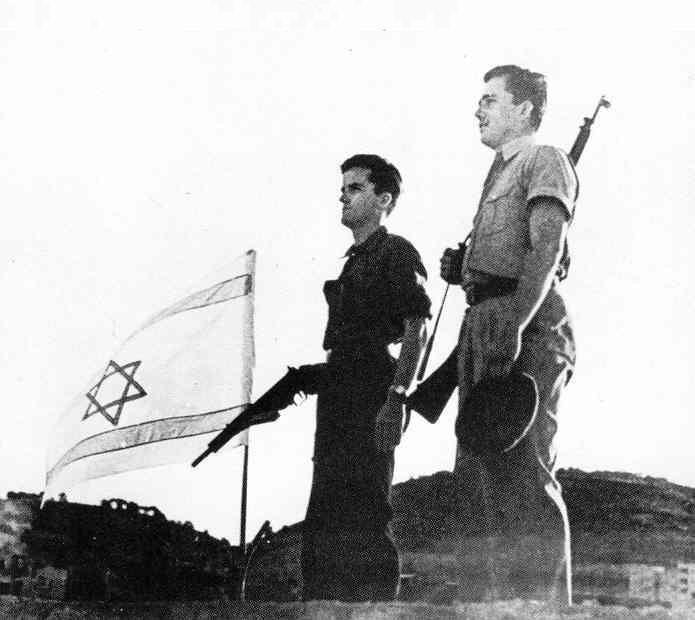
On May 14th, 1948 Britain's
mandate over Palestine ended.
That afternoon the Jews
announced the creation of Israel. On the following day the Arab-Israeli
war began.
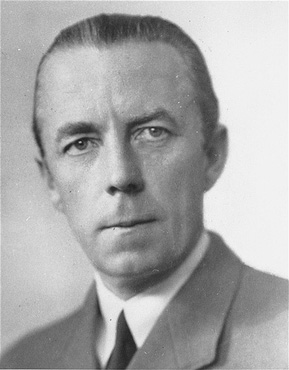
Official UN mediator, Count
Folke Bernadotte, assassinated by Jewish terrorist
organization Lehi (the Stern Gang) in September 1948
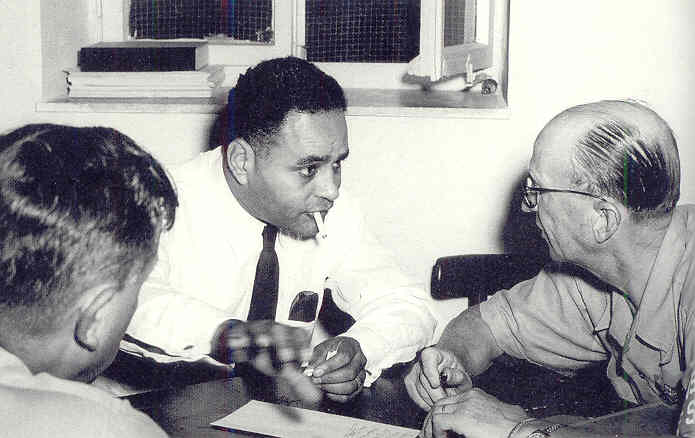 U.S. diplomat Ralph Bunche,
who replaced Bernadotte, mediating the Palestinian conflict
U.S. diplomat Ralph Bunche,
who replaced Bernadotte, mediating the Palestinian conflict
United Nations
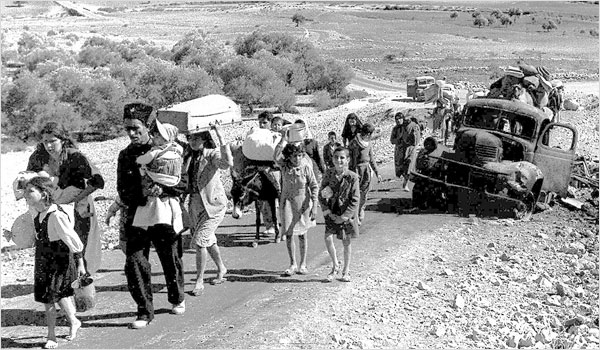 Palestinian refugees "Making
their way from Galilee in October-November 1948".
Palestinian refugees "Making
their way from Galilee in October-November 1948".
Front cover of The Birth
of the Palestinian Refugee Problem by Benny Morris
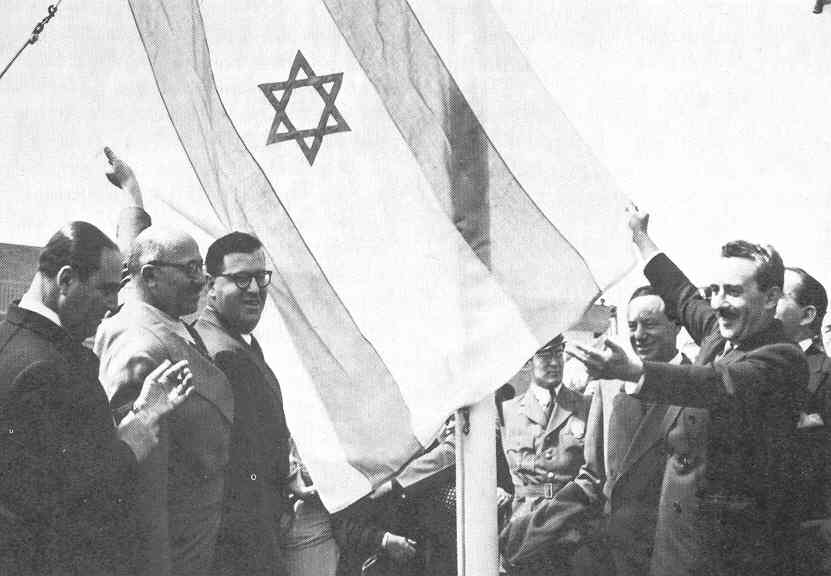
Israelis raise their national
flag at the United Nations
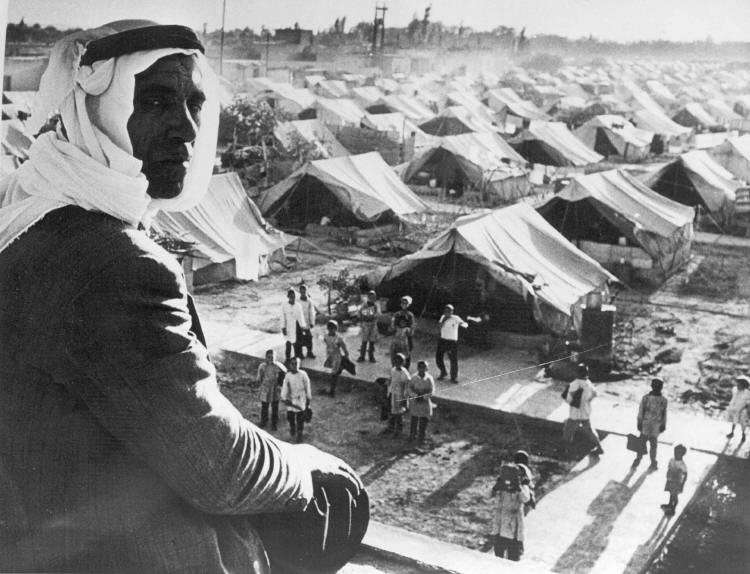
Jaramana Refugee Camp for
Palestinian refugees, Damascus, Syria - 1948
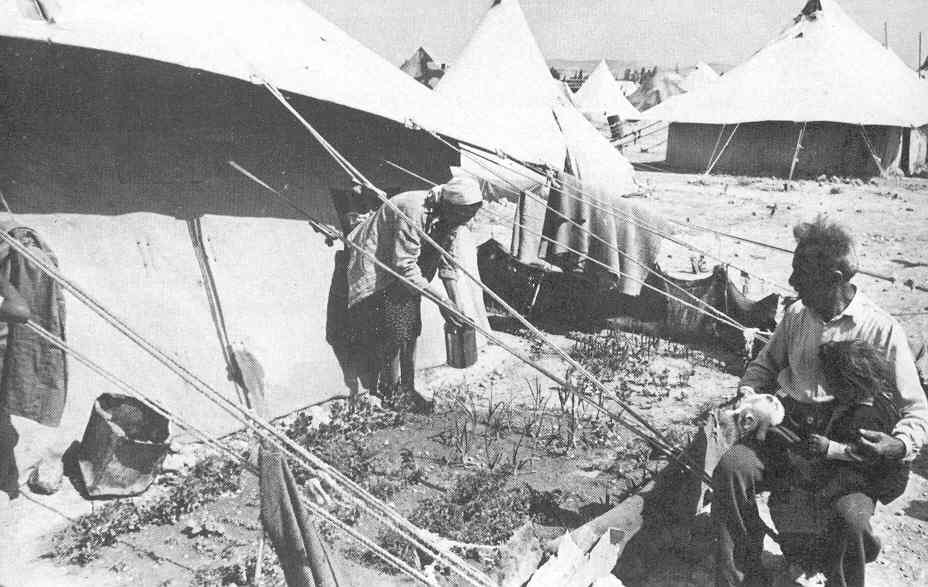
Palestinian refugees in Zerka
refugee camp - 1949
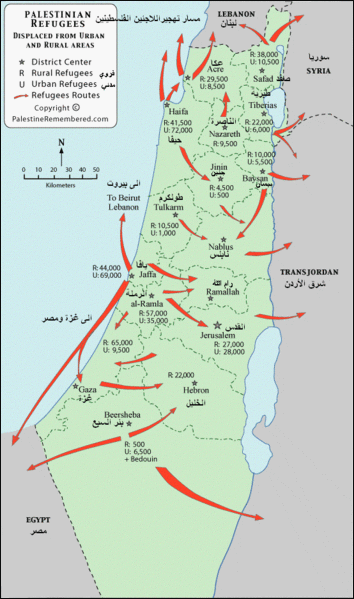
Refugee routes of
Palestinians
Wikipedia - "Palestinian
refugee"

Go on to the next section: The Cold War – An Overview
 Miles
H. Hodges Miles
H. Hodges
| | | | | |


 American "Anti-Imperialism ... and the
American "Anti-Imperialism ... and the Gandhi and Indian independence
Gandhi and Indian independence
 The collapse of the Dutch East Indies
The collapse of the Dutch East Indies The French stumble in Indochina
The French stumble in Indochina
 The Israeli-Palestinian Question
The Israeli-Palestinian Question









































 The Vietnamese Emperor Bao
Dai – in exile in Hong Kong – 1948. He was returned to Saigon
in 1949 in a French effort
to form a new non-Communist
government
The Vietnamese Emperor Bao
Dai – in exile in Hong Kong – 1948. He was returned to Saigon
in 1949 in a French effort
to form a new non-Communist
government














































